i
Satureja hortensis • Savory
(Previously Calamintha hortensis)
FAMILY: Labiatae.
DESCRIPTION: Small herb with sparse foliage. Height: 1 foot (30 cm). Width: IV 2 feet (45 cm). Flowers: Pale lavender to white, sparse. Leaves: Dark green, on reddish stems, linear, to Vs inch (2.2 cm) long. Blooms: August to September.
HABITAT: The Mediterranean, introduced into southwest Asia and Africa.
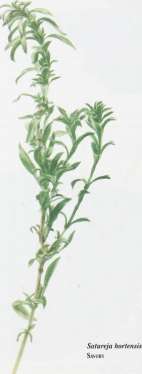
CULTIVATION: Annual. Germination: 2 to 3 weeks. Space:
1 foot (30 cm). Soil Temperature: 68° F (20° C) at night and 86° F (30° C) during the day. Soil: Well drained, moist underneath, but dry on surface. pH: 7 to 8. Sun: Full sun. Propagation: By seed. It can become top-heavy as it matures and may need bracing. GARDEN DESIGN: Summer savory is not known for design qualities, but it has a wonderful aroma. It tends to look best planted in small patches. For low borders, plant winter savory. CONSTITUENTS: Essential oil (1.5%) includes carvacrol, cymene.
RELATED SPECIES: Winter savory (S. montana) is a perennial that sometimes replaces summer savory, although it is more pungent and not quite so tasty. Yerba buena (S. douglasii) was used by California Indians to relieve colic, purify the blood, reduce fevers, alleviate arthritis, and as a general tonic.
HISTORY: Called summer savory to distinguish it from its winter cousin, this herb has probably been cultivated since very ancient times. The Romans enjoyed satureja vinegar, and Virgil suggested planting the herb near bee hives to improve the honey. Perhaps he also considered the instant relief if offers when placed on bee and wasp stings. Italians cultivated it in the 9th century and claimed it had aphrodisiac properties. The English took the name savory from the French sauore.
CULINARY: Savory is found so often in pea and bean dishes that the Germans call it bohnenkraut, or “bean herb.” In recipes, it offers a lighter substitute for sage or a stronger version of mint. For a change of pace, substitute a .savory garnish in place of parsley or chervil. The essential oil is used commercially as a flavoring in salami and other foods.
MEDICINAL: Savory has been found to destroy bacteria and to reduce muscle spasms.' It also kills intestinal worms. Like many culinary herbs, it improves digestion and also relieves intestinal gas, probably one reason it is so popular with bean dishes. It also helps to eliminate lung congestion.
Marinated Savory Beans
Other beans, such as garbanzos, may be substituted.
2 cups (500 ml) green beans, cooked
2 tablespoons (30 ml) lemon juice V 2 cup (120 ml) vinegar
3 to 6 garlic cloves, whole
1 teaspoon (5 ml) savory
Combine ingredients and let sit at least I week. Drain and serve.
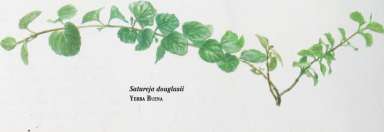
SCUTELLARIA LATERIFLORA
Scutellaria lateriflora • Skullcap
FAMILY: Labiatae.
DESCRIPTION : Height: 1 to 2 feet (30 to 60 cm). Width; 8 inches (20 cm). Flowers: Small, blue, in clusters on upper areas of stems, about Vs inch (8 mm) long. Leaves: Thin, almost oval coming to a sharp point, toothed around the edge. Blooms; July to September. HABITAT: United States, Newfoundland to British Columbia and south to Georgia, and California, in wet places. CULTIVATION: Perennial. Zone: 4 to 5. Germination: 3 to 4 weeks. Space; 6 to 10 inches (15 to 25 cm). Soil Temperature: 60° to 70° F (15° to 21° C). Soil: Moist. pH: 6 to 8. Sun; Partial shade. Propagation; By seed or by root division. It spreads on its own, but not too quickly and can be easily contained.
GARDEN DESIGN: A small plant that easily fades into the background, skullcap can be highlighted by growing it in a patch enclosed by stones or in a raised bed. It does well in a pot, provided the soil stays moist.
CONSTITUENTS: Flavonoid glycosides (scultellonin, scutel-larinan), essential oil.
RELATED SPECIES: A number of species, including S. galeri-culata and S. minor, both native to Europe, have similar properties. In traditional Chinese medicine, S. baicalensis is a sedative that relieves muscle and rheumatism pains, lowers fever, expels tapeworms, and corrects some heart conditions. True skullcap is dried to very little weight and is often substituted in the United States with the heavier and more abundant germander {Teucrium species). HISTORY: Skullcap was such a well-known remedy for rabies, it was once even called “mad-dog weed.” This property was discovered by Dr. Lawrence Van Deveer in 1773, although his claim was never substantiated. Rafinesque, in his 1830 Medical Flora, said that his use of the herb “prevented 400 persons and 1,000 cattle from becoming hydrophobic.” It found its way into many 19th century patent medicines as a nerve tonic, especially for “female weakness,” and as an epilepsy “cure.”
MEDICINAL: Skullcap leaves are used mostly for their actions on the nervous system: They help relieve anxiety, depression, insomnia, nervous headache, nervous twitches, muscle cramps, and convulsions. The Eclectic doctors of the nineteenth century found skullcap helpful in cases of nervousness due to emotional stress or physical exhaustion and used it as a bitter to stimulate digestion. Although few scientific studies have been performed on this species, it is likely that it possesses many of the medicinal properties found in similar species. Most of the research that has been done comes from Russia, where studies support many claims of skullcap’s usefulness as a sedative and stabilizer of stress-related heart disease.' Those studies also discovered that it lowers blood pressure and cholesterol. Native Americans did use skullcap to treat heart disease, as well as to promote afterbirth and menstruation. Herbalist Michael Tierra has found skullcap helpful in combating drug and alcohol withdrawal symptoms. Clinical tests with S. baicalensis in China found it improved symptoms in over 70% of patients with chronic hepatitis, increasing appetite, improving liver function, and reducing swelling.^ Other studies show it reduces inflammation and allergic reactions.
CONSIDERATIONS: Very large doses are said to cause dizziness, erratic pulse, and mental confusion.
OTHER: Skullcap is used in homeopathy.
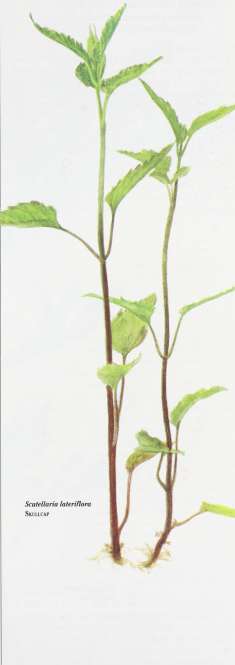
Senecio cineraria • Dusty Miller
(Previously Cineraria maritima and Centaurea maritima ‘Diamond’)
FAMILY: Compositae.
DESCRIPTION : Silver, woolly white herb. Height: 2 V 2 feet (75 cm). Width; 1 foot (30 cm). Flowers: Yellow or cream, V 2 inch (1.25 cm) across, 12 to a bunch. Leaves: 6 inches (15 cm) long, thick, woolly with dense white hairs underneath, in 10 to 12 segments so divided, they appear to be individual leaves. Blooms: July to September.
HABITAT: The Mediterranean.
CULTIVA TION: Perennial. Zone: 6. Germination: 10 to 15 days. Space: 8 to 10 inches (20 to 25 cm). Soil Temperature: 65° to 70° F (18° to21° C). Soil: Light and well drained. pH; 7 to 8. Sun: Full sun. Propagation: By cuttings, layering, or seeds. Start seeds in early spring or 8 to 10 weeks before last frost.
GARDEN DESIGN: This silver-gray plant is very popular in herb gardens, where it stands out with its contrasting color and leaf
texture. Keeping flowers cut off encourages more foliage and keeps the plant from looking leggy.
CONSTITUENTS: Pyrrolizidine alkaloids (jacobine, jacodine, senecionine).
RELATED SPECIES: The ornamental S. viro-vira has more finely cut foliage and no ray petals on the flowers. S. cineraria ‘Dwarf Silver’ is a short, 9-inch (22.5-cm) version with leaves even more divided'. Life root (S. aureus) is still an ingredient in Lydia Pinkam’s women’s herbal formula for genitourinary problems. HISTORY: Cineraria means “’ashy gray,” the coloring that also gives this herb the common name of “dusty.” The color was also said to resemble the dusty white wings of the miller moth. (The miller moth itself was named after the dusty clothing worn by grain millers in previous centuries.)
MEDICINAL: Sterilized plant juice has been used for eye drops for capsular and lenticular cataracts.
CONSIDERATIONS: Dusty miller and the other species mentioned all contain pyrrolizidine alkaloids, which are presently under scientific scrutiny for .safety.'
Senecio cineraria Dusty Miller
S / L Y B U M M A R I A N U M
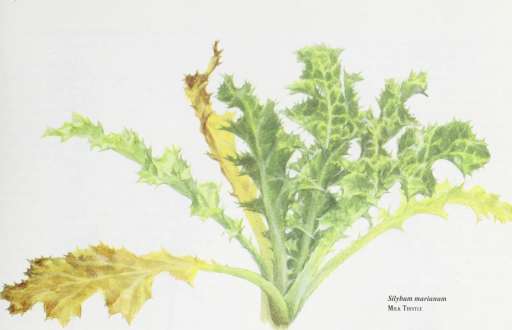
Silybum marianum • Milk Thistle
(Previously Carduus marianus)
FAMILY: Compositae.
DESCRIPTION : Wide, bristly plant —obviously a thistle. Height: To 4 feet (1.2 m). Width; 2 to 3 feet (60 to 90 cm). Flowers: Bristly tight cup, deep purple, 2 inches (5 cm) across. Leaves; Large, 2'/2 feet by 1 foot (75 cm by 30 cm), glossy, thick, marbled with white veinlike patterns, prickly edges. Fruit: Oval, smooth, mottled with brown. Blooms: June to September.
HABITAT: The Mediterranean, naturalized as a weed on the West Coast of the United States, in dry, rocky areas,wastelands, and fields. Naturalized in Australia and on various noxious weed lists. CULTIVATION: Annual or biennial. Germination: 10 to 15 days. Space: 3 feet (90 cm). Soil Temperature; 65° to 75° F (18° to 24° C). Soil: Well drained, dry, very drought tolerant. pH; 6-8. Sun; Full sun. Propagation: By seed. Since it reproduces by seed, it is easy to keep under control in a garden setting.
GARDEN DESIGN: If you know this thistle as a weed, you may question putting it in your herb garden, yet its attractive, mottled leaves are very interesting and stand out beside other herbs. CONSTITUENTS: Seeds: essential oil, flavolignans called silymarine, such as silybin.
RELATED SPECIES: Also known as variegated thistle and Our Lady’s Thistle. Not closely related to holy or blessed thistle (Cnicus benedictus), although they are often confused with each other. HISTORY: Early Christian tradition dedicated milk thistle to Mary, calling it Marian thistle. It was considered interchangeable
with blessed thistle (Cnicus benedictus). Long before research was done on the herb, it was suggested as a bitter digestive, liver tonic, and poison antidote. German physician Rademacher reported success in giving it to his liver patients in the early 19th century. CULINARY: Dioscorides suggested eating silybon “sodden with oil and salt,” which would probably hide the taste of anything. Actually, the steamed leaves are quite tasty, providing the prickly edges have been cut off! The young stalks were once widely cultivated as a vegetable, and their taste was considered superior to that of cabbage in the 18th century. The seeds, with a slightly bitter nutty flavor, can be ground and sprinkled on food.
MEDICINAL: Milk thistle has been proven to protect the liver from damage—even against the deadly deathcap mushroom (Arnacitaphalloides), which contains some of the most potent liver toxins known. When silybin, a constituent from milk thistle, was injected into human patients up to 48 hours after they accidentally ingested deathcap, it prevented the normally anticipated fatalities.' Many commercial preparations are manufactured in Germany from the seeds. An official Tinctura Cardni Marine Rademacher is still listed in the pharmacopoeias of some countries. The latest research will probably reestablish milk thistle’s place as a medicine, at least in some synthesized version. Clinical studies show that symptoms of acute hepatitis, especially digestive problems, improved within 2 weeks of taking milk thistle. Well-being and appetite also improved. It also has successfully treated patients with chronic hepatitis and cirrhosis of the liver.^ The detrimental effects of jaundice, drugs, environmental toxins, and alcohol on the liver may be countered with milk thistle. More information can be found in Milk Thistle: The Liver Herb by Christopher Hobbs (Botanica Press, 1985).
s
S T A C H Y S BYZANTINA
i
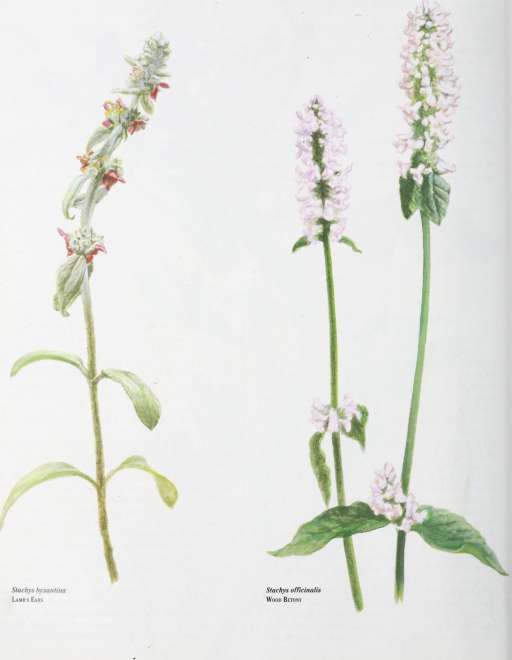
S T A C H Y S OFFICINALIS
Stachys byzantina • Lamb’s Ears
(Previously S. lanata, S. olympica)
FAMILY: Labiatae.
DESCRIPTION: Erect, furry leaves. Height; To 3 feet (90 cm). Width: 1 foot (30 cm). Flowers: Purple or pink, to 1 inch (2.5 cm), running along furry, white, 12-inch (30-cm) stalks. Leaves: Thick, long, very soft and covered with woolly, white hairs. Blooms: May to June.
HA BIT A T: Turkey, southwest Asia.
CULTIVATION: Perennial. Zone; 2 to 3. Germination; 1 to 2 weeks. Space; 8 to 15 inches (20 to 38 cm). Soil Temperature: 70° F (21° C). Soil: Fairly rich, well drained, but tolerates poor conditions. pH; 7.5 to 8.5. Sun: Full sun, or partial shade. Propagation; By seed or divide root clumps. It spreads easily on its own.
GARDEN DESIGN: The soft, gray leaves of lamb’s ears provide excellent contrasts in any garden. It is a favorite plant of children so be sure to place it where they can easily feel its furry leaves. It forms an ornamental groundcover that is ideal for lining the edges of pathways.
CONSTITUENTS: Essential oil, tannin.
RELATED SPECIES: Related to betony (IS. o7//'c/no//s/ HISTORY: The exceptionally fuzzy leaves gave it the names lamb’s ears and woolly betony.
CULINARY: Lamb’s ears make a light-tasting tea. The leaves can be steamed and eaten, although some people find their fuzziness unappealing.
MEDICINAL: Also called woundwort, lamb’s ears makes a natural bandage and dressing to staunch bleeding.
Stachys officinalis • Wood Betony
(Previously S. betonica, Betonica officinalis)
FAMILY: Labiatae.
DESCRIPTION: Softly textured bush. Height: 2 to 3 feet (60 to 90 cm). Width; 2 feet (60 cm). Flowers: Bright blue, V 4 inch (6 mm), arranged in whorls on the top of the spikes. Leaves: A rosette of stiff, slightly hairy, pointed leaves, about 5 inches (12.5 cm) long. Blooms: July to August.
HA BITA T: A European native that has naturalized itself in many parts of the world.
CULTIVATION: Perennial. Zone: 4. Germination; 15 to 20 days. Space: 14 to 18 inches (35 to 45 cm). Soil Temperature: 70° F (21° C). Soil: Well drained, dry. pH: 6.5 to 7.5. Sun: Full sun. Propagation: Easily grown from seed or divided by prying apart the thick clumps, or by cuttings.
GARDEN DESIGN: A well-contained herb that can be used as a high border or set near the back of the bed. It is most noticeable when flowering, since the vivid blue flowers are highlighted against pinks, grays, and greens.
CONSTITUENTS: Tannins (to 15%), saponines, glucosides, alkaloids (bettonicine, stachydrine, trigonelline).
RELATED SPECIES: Lamb’s ears, or woolly betony (5. byzan-tina), a very attractive herb with furry white leaves, is a children’s favorite. It is perfect for rock gardens or as a groundcover. A white betony (S. officinalis ‘Alba’J has white instead of blue flowers. This
betony is not related to the wood betonys (Pedicularis species) or lousewort (P. syluatica), which is also a headache remedy. HISTORY: An old Italian proverb indicated this herb’s value when it declared, “Sell your coat and buy betony.” The Spanish agreed, complimenting each other with the phrase, “He has as many virtues as betony.” Betony was also appreciated by the ancient Greeks, the Romans, and the Anglo-Saxons, who discussed it in their 11th century Lacnunga. A treatise written by Antonius Musa, physician to Emperor Augustus, listed 47 diseases that could be helped by betonica. The name was derived from vettonica, from the Vettones, an ancient people inhabiting the Iberian peninsula. MEDICINAL: Betony, which means “head herb,” was a traditional remedy for problems associated with the head; the Medicina Britannica of 1666 states, “I have known obstinate headaches cured by daily breakfasting for a month or six weeks on a decoction of Betony.” It was also used to treat giddiness, dizziness, and hearing difficulties. The British traditionally relieved headaches by snuffing or smoking betony leaves combined with eyebright and coltsfoot in the famous “Rowley’s British Herb Snuff.” The French recommended the leaves of beteine for lung, liver, gallbladder, and spleen problems. One of its constituents, trigonelline, also found in fenugreek, has been shown to lower blood sugar levels. Betony was appropriately known as woundwort, since applied externally it stops bleeding, promotes healing, and draws out boils and splinters.
OTHER: A dark yellow dye can be extracted from betony. It makes an attractive cut flower, as well.
Symphytum officinale • Comfrey
FAMILY: Boraginaceae.
DESCRIPTION: Densely growing patches of leaves. Height: 3 feet (90 cm). Width: 2 to 3 feet (60 to 90 cm). Flowers: Purple-pink, hanging in bell-like clusters from the tips of the stems. Leaves: Tall, rigid and very prickly to the touch, to 1 foot (30 cm) tall, 5 inches (12.5 cm) wide, on hollow, bristly stems. Roots: Thick, fleshy roots that can trail 6 feet (1.8 m). Blooms: April to September.
HA BITA T: Most of the 25 or so species are native to Europe and Asia, but comfrey has naturalized itself elsewhere, including parts of the United States, mostly in rich, wet meadows and ditches. CULTIVATION: Perennial. Zone: 3. Space: 2 feet (60 cm). Soil: Moist, fairly rich. Sun; Full sun to partial shade. Propagation: Comfrey propagates so readily from even the smallest piece of root, that it is rarely grown from seed, and often does not produce seed. Repeated cuttings can produce 4 to 10 harvests of comfrey in one season.
GARDEN DESIGN: Comfrey is difficult to eradicate once established. If you want to include comfrey in a small garden, plant it in a submerged barrel or pot with drainage holes in the bottom. CONSTITUENTS: Mucilage, allantoin, protein (to 35%), alkaloids (including pyrrolizidine), sterols, zinc, tannic acid, asparagine, vitamin B 12 .
RELATED SPECIES: Russian comfrey (S. x uplandicum) has been considered superior, but does contain more pyrrolizide alkaloids. It has been used very little in Russian folk medicine. S. officinale ‘Variegatum’ has white-rimmed leaves.
SYMPHYTUM OFFICINALE
i
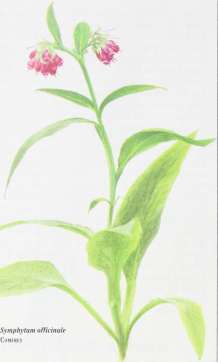
HISTORY: The name comfrey comes from the Latin con firma, “with strength,’’ and Symphytum is derived from the Greek symphy-tos, “to unite.” It is also popularly called knitbone. The gummy root, when spread on muslin and wrapped around a sprain, torn ligament, or broken bone that has been set, stiffens into a cast. Squires in The Companion to the 17th-century British Pharmacopoeia, 1916, describes a bonesetter who used comfrey in this manner. A few avid Englishmen began promoting comfrey as fodder in the late 19th century. Henry Doubleday first used comfrey to substitute for the difficult-to-obtain stamp glue known as gum arabic. CULINARY: The leaves, steamed like a vegetable, lose their prickly texture and can be eaten, but read “Considerations” first. MEDICINAL: Comfrey leaves and especially the root contain allantoin, a cell proliferant that increases the healing of wounds. It also stops bleeding, is soothing, and is certainly the most popular ingredient in herbal skin salves for wounds, inflammation, rashes, varicose veins, hemorrhoids, and just about any skin problem. Taken internally, comfrey repairs the digestive tract lining, helping to heal peptic and duodenal ulcers and colitis (inflammation of the colon). Studies show it inhibits prostaglandins, which cause inflammation of the stomach lining.' Comfrey has been used to treat a variety of respiratory diseases, and is a specific when these involve coughing of blood.
CONSIDERATIONS: Investigations on pyrrolizidine alkaloids (PA) have found over 200 types occurring in about 3 % of the world’s
plants, including comfrey. In one study, rats fed a comfrey diet (up to 33%) developed liver cancer. The isolated symphytine, one of 8 pyrrolizidine alkaloids identified, was also found to produce liver cell tumors in rats.^ So far, only two cases of possible comfrey poisoning have been reported in people. One was a 13-year-old British boy who ate comfrey regularly for about 3 years, but the researchers admitted that he “may have been more susceptible . . . because of his underlying inflammatory bowel disease.” They also stated. These alkaloids are less toxic than those in other plants—for example Senecios—which may explain why only a few cases of hepatic veno-occlusive disease caused by ingestion of comfrey are known.” Scientists assume that applying comfrey externally, as in poultices and salves, is perfectly safe. As far as internal use goes, the fresh root contains approximately 10 times more PA than fresh leaves.^ Fresh, young, spring leaves average .22% PA, young fall leaves have .05% PA, mature leaves have only .003% PA, and two investigations did not detect PA at all in dried leaves.' It is interesting that water extracts of the whole leaves actually decreased tumor growth and increased survival time in cancer patients.® The Ames test for toxicity showed comfrey produced le.ss mutants than the control, suggesting it may have anticancer activity. Some reports on comfrey’s toxicity have resulted from a mistaken identification of the poisonous foxglove—the leaves of which resemble comfrey. A complete modern history is found in Comfrey: Fodder, Food, and Remedy by Lawrence D. Hills (New York: Universe Books, 1976). OTHER: Comfrey is a rich addition to the compost pile.
Tagetes patula • French Marigold
FAMILY: Compositae.
DESCRIPTION: A densely compact annual producing many flowers. Height: 2 feet (60 cm). Width: 1 foot (30 cm). Flowers: Various combinations of orange, yellow, red-brown, 2'/2 inches (6.25 cm) across. Leaves: Divided with ragged edges. Blooms: July to August.
HABITAT: Mexico.
CULTIVATION: Annual. Germination: 5 to 7 days. Space: 6 to 12 inches (15 to 30 cm). Soil Temperature: 70° to 75° F (21° to 24° C). Soil: Dry, well drained, fair—too rich a soil produces more foliage and less flowers. pH: 4 to 6. Sun: Full sun, open location. Propagation: Very easy to cultivate by seed. In cold climates, start indoors 6 to 8 weeks before the last frost. In warmer areas, sow from midsummer through autumn to avoid hottest weather during flowering, or any frost. Picking the flowers increases the bloom. GARDEN DESIGN: Single-petaled forms are the most popular. The abundant flowers and long blooming season make French marigolds perfect for filling in empty spots. They make a low, easily controlled, and colorful hedge.
CONSTITUENTS: Essential oil includes limonene, carvone, citral, camphene; valeric acids, salicylaldehyde, tagetones. RELATED SPECIES: Many flower sizes and colors in various cultivars; most have an extended flowering season, and some resist heat better. They are often confused with pot marigold (Calendula officinalis). Tangerine gem’ (7? tenuifolia cultivar) has distinctly lemon-scented leaves. There is also an orange-scented marigold {T. tenuifolia ‘Pumila’).
T A G E T E S P A T U L A
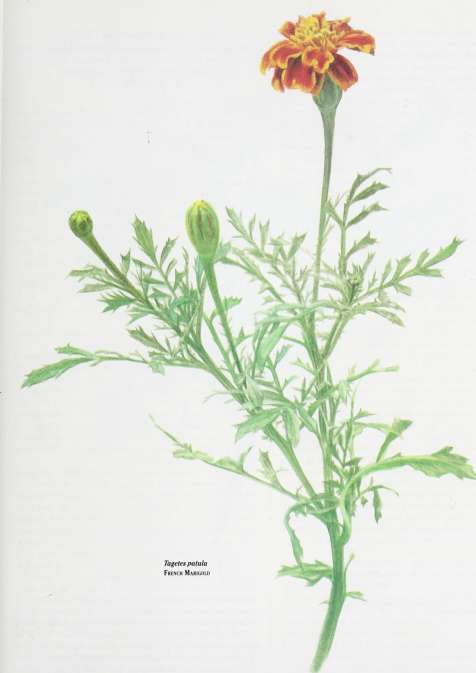
T A G E r E S P A T U L A
t
HISTORY: Early Mexicans fed marigold petals to chickens to color their skin and to brighten their eggs. For centuries, long before the term ‘companion planting” was coined, the South American Incas interplanted marigolds with their potatoes to reduce insect damage. According to Robert Sweet, in his Hortus Bri-tannicus{\S26), the marigold arrived in Europe in the 16th century. Thinking they came from India, the botanist Pierandrea Mattioli designated them Caryophyllus indicus, ‘‘a clove pink from India.” They were in high fashion in both Europe and the United States throughout the 19th century and still find a place in flower, vegetable, and herb gardens. In Holland, they are still interplanted with roses as an insect repellent.
CU LIN ARY: The oil is a food flavoring in frozen dairy des.serts, baked goods, gelatins, puddings, relishes, and some alcoholic and nonalcoholic beverages.
MEDICINAL: Marigold flowers were an Aztec remedy for coughs and dysentery (probably T. erecta). Various species, especially T. minuta, have also been used to lower blood pressure, as a tranquilizer, to dilate the bronchials, and to reduce inflammation. The leaves were placed on skin sores and made into a wash for inflamed eyes. The Chinese find T. erecta useful in treating whooping cough, mumps, and colds. South Americans use various species to eliminate intestinal parasites and colic. The polyacetylenes in French marigolds have displayed some anticancer properties. CONSIDERATIONS: Some people get a contact skin dermatitis from touching marigolds.
OTHER: Researchers at the University of British Columbia, Vancouver, found that French marigolds actually attack some insects. The polyacetylenes they contain excite surrounding oxygen when activated by light every time a munching insect breaks the leaf cells. Scars have actually been found on insects the plant has attacked. Marigolds also inhibit the ability of some insects to detect surrounding vegetables, and they deter white flies; T. minuta even kills surrounding weeds. Naturalized in Australia, this species is known as stinking Roger. In studies at the University of California, San Jose, French marigold greatly reduced cabbage worm eggs and larvae and worm damage, although 4 plants were required in every 14-square-inch (90-square-cm) plot! The only problem is that crop yields were also reduced. The roots exude a substance that deters nematodes, destructive microinsects found in soil. Scientists also found that a diluted tea of the flowers is lethal to mosquito larvae.' French marigold flowers look great and are long-lasting, although their strong smell has kept them from being placed in vases as often as other species. The rich marigold color also is u.sed in potpourri and produces a yellow dye on silk and wool.
As for marigolds, poppies, hollyhocks, and valorous sunflowers, we shall never have a garden without them, both for their own sake, and for the sake of old-fashioned folks, who used to love them.
— ''Star Papkrs" A Discourse m Flowers. HE^RY Ward Beecher ( 1813 1878 ), American
Tanacetum parthenium • Feverfew
(Although listed as Chrysanthemum parthenium in Hortus Third, the newest name is welLestablished. Previously Pyrethrum parthenium and Matricaria parthenoides,
M. capensis, M. eximia)
FAMILY: Compositae.
DESCRIPTION : Small, bushy herb, strongly scented. Height: To 4 feet (1.2 m). Width: 2 feet (60 cm). Flowers: Daisylike, with white petals and raised yellow centers, 1 inch (2.5 cm) in diameter, clustered together with up to 30 heads. Leaves: Yellow-green, divided, flexible, shaped like miniature oak leaves, 3 inches (7.5 cm). Blooms: June to August.
HABITAT: Native to southeast Europe; introduced elsewhere. Brought to America as an ornamental, it proceeded to make itself at home. Cultivated commercially in Japan, Kenya, South Africa, and parts of central Europe.
CULTIVATION: Perennial. Zone: 4. Germination: 10 to 14 days. Light improves germination. Space: 8 to 12 inches (20 to 30 cm). Soil Temperature: 70° F (21° C). Soil: Well drained, average. pH: 5 to 7.5. Sun: Full sun or partial shade. Propagation: By seed or by cuttings (taken with the heel of the plant intact).
GARDEN DESIGN: The small, white flowers show up especially well against dark green plants like betony or next to a fence. CONSTITUENTS: Essential oil, sesquiterpene lactones (par-thenolide, santamarine).
RELATED SPECIES: A golden-leaved feverfew (T. parthenium ‘Aureum’) is available.
HISTORY: Feverfew has experienced a botanical-name identity crisis. The Greeks called it pyrethron, probably from pyro, meaning “fire,” descriptive of its taste. This became pyrethrum to the Romans. Feverfew was first designated botanically as Matricaria as a close relative of chamomile—an herb for which it is often mistaken. Since then, it has joined forces with the chrysanthemums and the pyrethrums and now shares the genus with tansy. Old England knew it as featherfew. While the common name feverfew, from the latin febri, or “fever,” represents one of its possible uses, herbalists rarely use it to reduce fevers.
CULINARY: Feverfew has been added to food to cut the greasy taste but is extremely bitter and disagreeable to most palates. MEDICINAL: Feverfew is gaining fame for its ability to alleviate migraine headaches. It is not a new idea. John Hill, in The Family Herbal, stated in 1772, “In the worst headache this herb exceeds whatever else is known.” Clinical studies at the Department of Medicine and Haematology at City Hospital in Nottingham, England, had 20 headache patients eat fresh feverfew leaves (.9 grain, or 60 mg) daily for 3 months and stop using headache-related drugs during the last month. After they were given capsules of .37 grains (25 mg) of freeze-dried leaf every day, they experienced less severe headaches and fewer symptoms, including nausea and vomiting, than a placebo group. As an added benefit, their blood pressure went down from an average of to ’^V 82 in six months. Some even described a renewed sense of well-being.' Perhaps Gerard was onto something in the 17th century when he suggested feverfew “for them that are giddie in the head . . . melancholike, sad, pensive.” Another, double-blind study saw a reduction of migraine headaches, as well as nausea, by 24 % in 72 volunteers." E. S. John-
TANACETUM PARTHENIUM
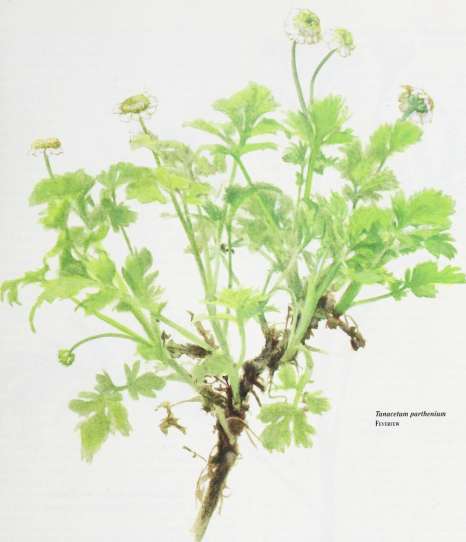
son, a feverfew researcher and author of Feverfew, A Traditional Herbal Remedy for Migraine and Arthritis (Sheldon Press, 1984), speculates that feverfew can help not only migraine, but premenstrual and menstrual headaches, as well as diseases caused by chronic inflammation, such as arthritis. It is hypothesized that feverfew prevents blood vessel spasms in the head by inhibiting amines, including serotonin, certain prostaglandins, and histamine that create inflammation and constrict blood vessels, which
may contribute to headaches, it may be more active than other nonsteroid, antiinflammatories, such as aspirin. For instance, it has not been shown to inhibit blood clotting.^ While many herbalists feel the fresh leaves, or an extract made from them, are preferred, results have been seen with fresh, freeze-dried, and air-dried leaves, although boiling feverfew tea for 10 minutes instead of steeping it did reduce its activity in one study. CONSIDERATIONS: Problems such as mouth ulcers and soreness and occasional digestive disturbances have been reported in about 18% of those using feverfew on a regular basis."'
OTHER: Feverfew is a moth repellent.
TAN A C E T U M V U L G A R E
*
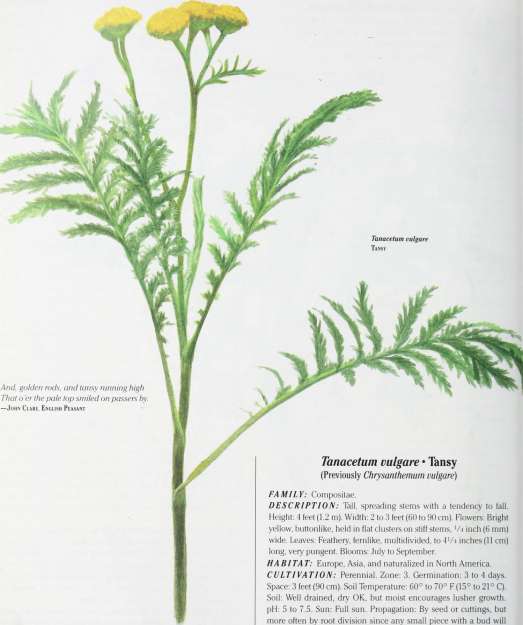
Tanacetum vulgare Tansy
Tanacetum vulgare • Tansy
(Previously Chrysanthemum vulgare)
FAMILY: Compositae.
DESCRIPTION: Tall, spreading stems with a tendency to fall. Height: 4 feet (1.2 m). Width: 2 to 3 feet (60 to 90 cm). Flowers: Bright yellow, buttonlike, held in flat clusters on stiff stems, V 4 inch (6 mm) wide. Leaves: Feathery, fernlike, multidivided, to 4'/4 inches (11 cm) long, very pungent. Blooms: July to September.
HA BITA T: Europe, Asia, and naturalized in North America. CULTIVATION: Perennial. Zone: 3. Germination: 3 to 4 days. Space: 3 feet (90 cm). Soil Temperature: 60° to 70° F (15° to 21° C). Soil: Well drained, dry OK, but moist encourages lusher growth. pH: 5 to 7.5. Sun: Full sun. Propagation: By seed or cuttings, but more often by root division since any small piece with a bud will gladly sprout.
And, golden rods, and tansy running high That o ’er the pale top smiled on passers by. —John Clare, English Peasant
TARAXACUM OFFICINALE
GARDEN DESIGN: Gardeners who prefer a trim garden tend not to appreciate tansy’s haphazard nature. It flops on plants next to it and spreads rapidly. It is helpful in restricted situations to keep the flower stalks under control by tying them together. I’ve found the best location is out of the main herb garden, as a border along a lawn, large path, or driveway, where it can be contained. CONSTITUENTS: Essential oil (from .12% to .18%) includes thujone (to 70%), borneol; glycosides; sesquiterpene lactones; terpenoids (pyrethrins), vitamin C; citric and oxalic acids. RELATED SPECIES: Curly leaf tansy ("Z" nu/gare var. cr/spum) with its finely cut, luxuriant foliage is more ornamental and easier to contain, although some curly forms don’t produce flowers. Botanists think that tansy has a number of subgroups, or races, distinguished by their different essential oil compositions. Tansy or common ragwort (Senecio jacobaea) is an unrelated European native with similar leaves that is considered a troublesome weed and poisonous to cattle in the United States, especially in Oregon, and in Australia, where it is considered a noxious weed. HISTORY: A Greek legend tells of a beautiful young man, Ganymede, who was given a tansy drink to make him immortal, so he could serve Zeus. The Greeks called it athanasia, or “immortality,” because, according to 16th-century herbalist Dodoen, the flower lasts so long. It became the Spanish atanasia, then the French tanaisie, and finally the English tansie. A favorite herb of Emperor Charlemagne, it was planted in all his monasteries. The monastery of St. Gall in Switzerland has grown it for over 1,000 years. CULINARY: In 1677, John Evelyn described eating a hot dish of young tansy leaves stir-fried with orange juice and sugar as “most agreeable.” Tansy was added to omelets and garnished other dishes. Elizabethan “tansies” were puddings flavored with the fresh herb that were purposely made with the bitter herb during Lent to offset the taste of salted fish. Chances are that tansy was eaten as a spring bitter long before Lent existed. William Coles, in 1656, wrote that it counteracted “the moist and cold constitution winter has made on people ...” The Irish in County Cork sometimes still use tansy to flavor their drisheens. In Scotland, the roots have been preserved in honey or sugar and eaten for gout. Some alcoholic beverages are still flavored with tansy, including Chartreuse, although it must be with a thujone-free extract. MEDICINAL: As Gerard said in the 16th century, tansy “be pleasant in taste and good for the stomache.” The constituent thujone kills intestinal roundworms and threadworms, scabies, and heals other infected skin conditions. Very small doses have been used to treat epilepsy and to encourage menstruation. CONSIDERATIONS: Tansy contains thujone, which is also found in wormwood. Potentially harmful to the central nervous system, an overdose can produce seizures. Don’t eat much tansy, and none if pregnant.
OTHER: Tansy deters ants (which means they walk around it instead of over it), fleas, and moths. Thomas Tusser, in his 1557 Strewing Herbs of All Sorts, described it as one of the best flea repellents. It was also rubbed over meat to keep flies away. A strong tansy tea repels several beetles, including the Colorado potato beetle (Leptinotarsa decemlineata), according to studies for Lehigh University in Pennsylvania. The leaves dye wood green and the flowers are excellent in dried flower arrangements and wreaths.
Taraxacum officinale • Dandelion
(Previously T leontodon and L. taraxacum)
FAMILY: Compositae.
DESCRIPTION : Compact, low-growing plant. Height: IV 2 feet (45 cm). Width: 2 feet (60 cm). Flowers: 1 bright yellow, sun-ray flower on a hollow stem. Opens with morning sun and closes in the evening. Leaves: Long, to 1 foot (30 cm), pliable, deeply toothed, growing from a central rosette. Fruit: White tufted globes, which are easily blown by the wind or children. Root: Fleshy taproot, brown with a milky, sap-filled core. Often 1 foot (30 cm) long and V 2 inch (1.25 cm) in diameter. Blooms: April to June.
HABITA T: A European and Asian native, dandelion has needed no encouragement to take up housekeeping elsewhere and has done so throughout North America and Australia. CULTIVATION: Perennial. Zone: 3. Germination: Varies greatly. Space: 8 to 10 inches (20 to 25 cm). Soil Temperature: 55° to 60° F (13° to 15° C). Soil: Not fussy! Prefers nitrogen-rich, slightly damp. pH: 4.2 to 8.2. Sun: Full sun. Propagation: Most people are more concerned about getting rid of dandelions than planting them, but they do grow sweeter leaves and roots when cultivated, and there is a large-leafed form sold for eating. Seeds sown in the autumn provide early spring greens. When growing dandelion for fancy salads, protect the plant’s leaves from sunlight so they blanch like chicory leaves, for a pale, less bitter flavor. Collect the roots in the autumn or early spring. Autumn-harvested roots have been the official herb used for medicine since they contain more bitters and inulin and have been considered more medicinal, although according to the British Pharmacopoeia, spring roots are less bitter and contain more taraxacin. The laevulose and sugar convert to inulin during the growing season, so fall extracts contain less sweetness and more sediment. Frost decreases the root’s properties. Old roots become leathery, twisted, and very bitter.
GARDEN DESIGN: If there are dandelions in your garden, you might as well make them prominent so visitors won’t think you simply forgot to weed. Just explain that weeds are defined as plants you don’f want!
CONSTITUENTS: Roots:taraxacin,triterpenes(taraxerol,tarax-asterol), inulin (about 25% in the autumn), sugars, glycosides, phenolic and citric acid, asparagine, vitamins A, C, B, potassium. Leaves: Carotenoids, vitamins A, B, C, D, minerals (potassium and iron). RELATED SPECIES: The true dandelion is often confused with a few different branched and bristly plants known collectively as “false dandelion” [Agoseris species). In China, T. monogolicum is used to treat infections, especially mastitis.
HISTORY: Dandelion was probably introduced into European medicine by the Arabs, who were writing about its virtues in the 10th century. Medieval pharmacists named it Taraxacum from the Greek taraxis, “to move or disturb”, but the name originally may have come from the Persian name for the herb, tarashqun. Both the Persians and East Indians used it for liver complaints. Dandelion became an official European apothecary drug in the 16th century, and one of the products sold was fresh dandelion juice. The shape of the leaves gives dandelion the French name, dents de lion, or “teeth of the lion.” Another French name, pis en lit, or “pee in bed,” celebrates its diuretic effects.
T A R A X A CUM OFFICINALE
Star-disked Dandelion, just as we see them, Lying in the grass, like sparks that have leapt From kindling suns of fire.
—■'Dandelion" The Professor at the Breakfast Table. Oliver Wendell Holmes (1809-1894), American
CULINARY: The young leaves, which are richer in vitamin A than carrots, can be mixed in salads or steamed and topped with a dressing. While in Greece, 1 dined every night on horta—a side dish of dandelions or other bitter greens drenched in olive oil. The English, who are not inclined toward bitter foods, do indulge in young dandelion greens on sandwiches with butter and salt, sometimes sprinkling them with pepper or lemon juice. Older leaves can be eaten if the'bitter center rib is removed. The Pennsylvania Dutch pour a dressing of hot cider vinegar and sugar over their dandelion salads—traditional fare for Maundy Thursday. The roasted root makes a coffeelike tea or is added to coffee as an extender. The taste of flower buds fried in butter somewhat resembles mushrooms, and the buds are added to eggs. The Arabians make a yublo cake of honey, olive oil, flour, rose petals, and dandelion buds. Dandelion flower wine and beer were originally tonics with less alcoholic and certainly more medicinal properties than commercial beer today. The English enjoyed dandelion, nettle, and yellow dock beer. Recipes are found in the booklet On the Trail of the Yellow Flowered Earth Nall: A Dandelion Sampler by Peter Gail (Goosefoot Acres Press, PO. Box 18016, Cleveland Heights, OH 44118—it also sells canned dandelion greens and Amish Dandelion Flower Jelly). MEDICINAL: Dandelion root is a “blood purifier” that helps both the kidneys and the liver to improve elimination. It helps clear up many eczema-like skin problems that result when the kidneys or liver don’t remove impurities from the blood. Used over a period of time, the root has successfully treated liver diseases, such as jaundice and cirrhosis, as well as dyspepsia, gallbladder problems, and gallstones.' It also improves appetite and digestion and is a mild laxative that works well to resolve chronic constipation. Clinical studies have favorably compared it to the often-prescribed diuretic drug Furosemide''” Instead of pulling potassium out of the body like most diuretics, dandelion helps the body to replace it.^ Most herbalists consider the root the diuretic of choice for treating rheumatism, gout, and heart disease. It is also suggested for women’s hormonal imbalances, especially those relating to liver or kidney problems, and Lydia Pinkham (1819-1883) included it in her famous women’s tonic. The leaves have some weak antibiotic action against Candida.
CONSIDERATIONS: The fresh latex that appears as white, sticky liquid in the root, and especially in the stem, can be caustic and cause skin irritations. One advantage of this property, however, is that it removes warts if applied religiously a few times daily. Use the dried root to prepare tea.
OTHER: It is an important honey plant, but the bees aren’t alone —about 93 species of insects visit dandelion for its nectar. During Word War II, a rubber latex was made from the Russian dandelion (T. kok-saghyz).
Dear common flower that grow st beside the way.
Fringing the dusty road with harmless gold First pledge of blithesome May
Which children pluck, and, full of pride, uphold High-hearted buccaneers, o erjoyed that they An Eldorado in the grass have found.
Which not the rich earth's ample round May match In wealth, thou art more dear to me Than all the prouder summer-blooms may be.
—“To The Dandelion " James Russell Lowell (1819-1891), American
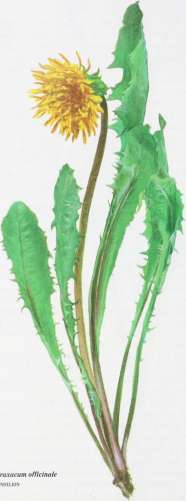
Taraxacum officinale Dandelion
T E U C R I U M CHAM A EDRYS
Dandelion Wine
4 quarts (4.51) water
3 quarts (3.51) dandelion blossoms, fully open and dry 3 pounds (1.35 kg) sugar
1 orange, sliced
2 lemons, sliced 1 yeast cake
Pour boiling water over the freshly picked blossoms. Let stand 3 hours. Strain the liquid into a large cooking pot and add sugar to the liquid. Cook over medium heat 15 minutes. Place orange and lemons in a 2-gallon (7.6-1) container. Pour the hot liquid over the fruit. When cooled to 100° F(37° C), remove 1 cup (240 ml) and dissolve the yeast in it, then add to the rest. Let sit 12 hours and strain. Return mixture to the container, cover with layers of cheesecloth and let stand at room temperature 2 months. Filter, bottle, cap, and store in a cool place. In 6 months, strain into bottles and sample.
Greek Horta
The traditional but less nutritious Greek method is to boil the greens. For other variations, serve this dish raw or combine the greens with other vegetables.
15 dandelion leaves
1 small onion, sliced 8 black olives
2 tablespoons (30 ml) olive oil
1 tablespoon (15 ml) cider vinegar or lemon juice Salt to taste
Steam dandelion leaves and onion until soft. Serve mixed with olives and topped with the oil and vinegar. Season with salt.
Teucrium chamaedtys • Germander
FAMILY: Lablatae.
DESCRIPTION : Low-growing, full shrub. Height; 1 foot (30 cm). Width: 1 foot (30 cm). Flowers: Purple, rose to whitish, small, growing among leaves on upright stems. Leaves; Stiff, small, gray-green, marked with purple. Oblong, somewhat oak-shaped, but toothed and slightly hairy, to V 2 inch (1.25 cm) long, aromatic. Blooms: June to September.
HABITAT: A Mediterranean native that also grows in Europe and Syria, often around ruins where it was once cultivated. CULTIVATION: Perennial. Zone: 5 to 6. Germination: 3 to 5 weeks. Space: 12 to 15 inches (30 to 37.5 cm). Soil Temperature: 70° F(21° C). Soil: Well drained, average, light, dry. pH: 7-8.5. Sun; Full sun. Propagation: Plant seeds, divide clumps, or take cuttings. May experience some winterkill in zones 5 to 6, but comes back if mulched during the winter.
GARDEN DESIGN: Germander is a popular edging plant because It has a compact growing style that is dense enough to be trimmed into a hedge and it puts on rapid growth after pruning, which quickly fills any gaps. It formed border designs in formal Elizabethan knot and maze gardens, often interwoven with thyme. The soft coloring of the leaves and flowers adds a nice contrast to herbs with deeper pink and purple flowers.
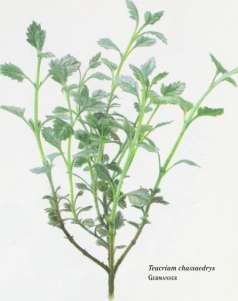
CONSTITUENTS: Essential oil includes caryophyllene (60%), glycosides, tannins.
RELATED SPECIES: Cat thyme ("T marum) has a sharp smell that cats enjoy. It is 12 to 18 inches (30 to 45 cm) high, with soft fuzzy leaves. It won’t tolerate winter temperatures below 20° F (-6.6° C). Dwarf germander [T. chamaedrys ‘Prostratum’) is a low-growing variety that forms a thick carpet. Wood sage, or garlic germander (T. scorodonia), with its green-yellow flowers and camphorlike fragrance, was used to bring on menstruation and as a treatment for skin- and blood-related diseases. The silver tree germander (T. fruiticans) Is a large, 4-foot (1.2-m) silver-green plant. Australian native germanders (T racernosum and T. corymbosum) are garden plants that are not used medicinally. T. polium treats digestive problems. Including ulcers. In Arab countries.
HISTORY: Germander is botanically named after Teucer (half-brother of Ajax), who gave it to his father-in-law. King Dardands of Troy, probably for gout. The herb had Its moment of historical glory when the 16th-century German Emperor Charles V was cured of gout after drinking germander tea for 60 days. It helped the Duke of Portland with the same malady In the 18th century and became the key Ingredient in Europe’s celebrated “Portland Powders.” They were manufactured well Into the 19th century. The 17th-century herbalist Culpeper suggested drinking germander tea as an antidote to poisons and applying it on snakebites. He also steeped the flowering tops in wine to kill intestinal worms.
CULINARY: Used In tonic wines and as a bitter flavoring in liqueurs and mixed drinks.
MEDICINAL: In addition to curing gout, germander is used to treat indigestion and to stimulate appetite and bile production. It was previously recommended to treat uterine obstructions and water retention and for reducing fevers. It was once considered horehound’s equal in relieving colds, flus, and coughs, although it is seldom used for those maladies today.
THALICTRUM AOUILEGIFOLIUM
t
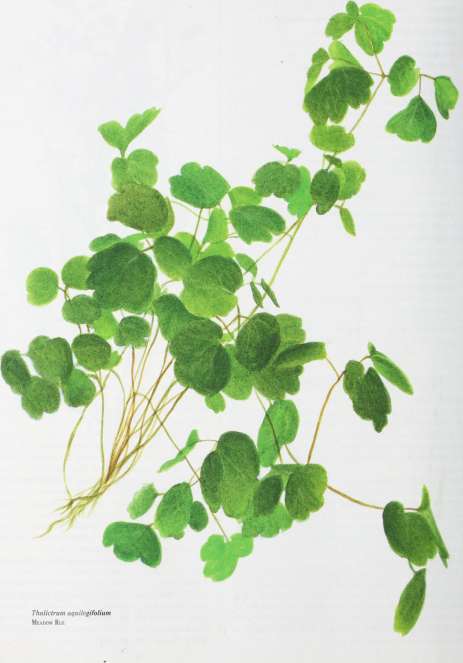
THYMUS VULGARIS
Thalictmm aquilegifolium • Meadow Rue
FAMILY: Ranunculaceae.
DESCRIPTION : Tall, graceful herb. Height: 3 to 6 feet (.9 to 1.8 m). Width: 2 feet (60 cm). Flowers: No petals, but with long pink or purple stamens that are very prominent, striking, in open clusters. Leaves: Blue-green, smooth, divided into 3 segments, often with rounded lobes, resembling columbine {Aquitegia species). Blooms: May to June.
HABITAT: Europe, Asia. ^
CULTIVA TION: Perennial. Zone: 5. Germination: 15 to 30 days. Space: 1 to 2 feet (30 to 60 cm). Soil Temperature: 50° to 60° F (10 to 15° C). Soil: Well drained, loamy, moist. pH: 5.5 to 7.5. Sun: Partial shade or full sun with plenty of water; complete shade in warmer regions. Propagation: By seed or root division.
GARDEN DESIGN: Very ornamental. Flowers have an airy quality. Choose a somewhat protected place because high winds can bend it over.
CONSTITUENTS: Alkaloid.
RELATED SPECIES: The popular flower garden cultivars and Asian species are available with different colored stamens. Southern Europe’s T. angustifolium was used in folk medicine to reduce fevers. In 1977, T. dasycarpum showed tumor-inhibiting properties, attributed to the alkaloid thalicarpine.
HISTORY: Dioscorides used the leaves of thalictrum (from tha-lic, “to bloom”) to cure old wounds. Gerard, calling it “bastard rhubarb” (probably T. minus), noted that the leaves and especially the roots were laxative. Native Americans considered purple meadow rue (T. dasycarpum) a love potion that could reconcile quarreling lovers. The seeds were sometimes placed in a couple’s food by relatives trying to restore peace in the home. Smoking the dried seeds was also said to bring luck in both hunting and courting. They used the stems for straws, and a few different tribes named it “hollow stem.” The leaves and seeds were placed on muscle cramps, and the seeds were sprinkled on herbal poultices to increase their potency. Roots were sometimes used on snakebites or made into a tea to reduce a fever.
MEDICINAL: Meadow rue is a purgative and diuretic. The 1916 U.S. Dispensatory described it as “bitter and tonic, for vaginal infection.” It is a bitter digestive tonic that contains berberine (also found in goldenseal) or a similar alkaloid. The leaves were sometimes added to spruce beer in the 19th century as a digestive tonic. CONSIDERATIONS: Handling the plant causes itching or dermatitis in many people.
OTHER: The leaves produce a yellow wool dye. The cut flowers of meadow rue are quite lasting, and the cut foliage resembles a large version of maidenhair fern. It can also be dried for wreath making.
Thymus vulgaris • Thyme
FAMILY: Labiatae.
DESCRIPTION : Creeping groundcover. Height: 1 foot (30 cm). Width: 1 foot (30 cm). Flowers: Small, white to lilac, V-4 inch (1.88 cm) long, densely cover plant. Leaves: Small, almost oval, coming to a point, very fragrant, Vie to Vs inch (5 mm to 16 mm) long. Blooms: May to August.
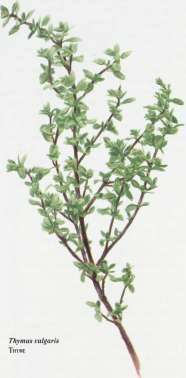
HABITAT: The west Mediterranean to southwest Italy, on dry, rocky soil. Cultivated commercially in Europe, especially Hungary and Germany.
CULTIVATION: Perennial. Zone: 4. Germination: 3 to4 weeks. Space: 1 foot (30 c '■). Soil Temperature: 55° F (13° C). Soil: Well drained, light, rather dry. pH: 6 to 8. Sun: Full sun. Propagation: By seed, cuttings, root division, or layering. The fine root system makes thyme more difficult than most herbs to move. Transplant it so it has plenty of time to establish its fine root system months before a hard freeze. Even established plants can be damaged if the soil freezes solid and heaves. A layer of sand on top of the soil helps prevent damage from freezes. Eventually the clumps die out in the center, but if this occurs after only 2 to 3 years, it can indicate poor growing conditions. Studies at the University of Granada, Spain, found that maximum essential oil potency occurs in the summer months of July and August.
GARDEN DESIGN: Thyme is suitable in rock gardens and borders, alongside pathways, and as a fragrant groundcover. It is used in Elizabethan-style, formal knot gardens because its dense growth allows trimming. Thyme looks particularly nice cascading over the side of a hanging pot or raised terrace. Different varieties planted together highlight each other’s colors.
THYMUS VULGARIS
i
CONSTITUENTS: Essential oil (to 2.5%) includes phenol, thymol (to 40%), carvacrol; terpenes; flavonoids; saponins. RELATED SPECIES: There are 200 to 400 species of thyme, including numerous cultivars. It is no surprise that there is confusion in proper identification, even in nurseries. All are suitable culinary herbs. “Flavors” include lemon thyme [T. x cltriudorus [pers.]). caraway thyme (T. herba-barona), creeping thyme (T. praecoxssp. arcticus), a tight, 4-inch- (10-cm-) tall groundcover with rosy, purple flowers.
HISTORY: Sumerian cuneiform tablets in 2750 B.C. suggested that thyme be dried and pulverized with pears and figs and enough water to make a thick paste for a poultice. The Egyptians used tharn, “thyme,” for medicine and to embalm their dead. The Romans liberally strewed thymum on their floors, burned it to deter venomous creatures, and flavored their cheese with it. Ancient Greeks felt complimented when told they “smelled of thymbra.”Then name for the herb (probably T. capitatus) might be associated with thymain, “to burn as incense,” and Ihyniete their word for altar, although most sources claim it came from thumus, meaning “energy.” For centuries, the bees on Mount Hymettus near Athens have produced a famous wild thyme honey. St. Flildegard mentioned it as a treatment for leprosy, paralysis, and “excessive” body lice.
CULINARY: Benedictine monks added it to their famous elixir. Today it is found in chowders, sauces, ton.atoes, gumbos, pickled beets, stews, stuffings, and many different vegetables. By the way, when cookbooks refer to a “sprig” of thyme, they usually mean a half teaspoon (2.5 ml).
MEDICINAL: Thyme’s main medicinal role is in treating coughs (including whooping cough) and clearing congestion. It makes an excellent gargle or mouthwash for sore throats and infected gums. Many pharmaceutical gargles, cough drops, mouthwashes, and vapor rubs contain thyme’s constituent thymol, which destroys bacteria, some fungus,' and the shingles virus (herpes zoster). Participants in a study who rinse twice daily with Lis-terine™, containing thymol (with eucalyptol and menthol), found they developed 34% less gum inflammation and new plaque formation. Thyme improves digestion, relaxing smooth muscles. It reduces the prostaglandins responsible for many menstrual cramps.^ Thyme also helps destroy intestinal parasites (especially hookworms and roundworms).
AROMATHERAPY: Rudyard Kipling wrote of the “wind-bit thyme that smells like the perfume of the dawn in paradise.” The fragrance of thyme is said to dispel melancholy and nightmares, at least according to 17th-century herbalist Culpeper. Both red thyme oil and the redistilled white thyme are available to use in baths for rheumatism, in liniments, and in massage oils. The term Ihy-miatechny, from thyme and techne, or “art,” was once used to describe the “art of using perfumes as medicine,” or aromatherapy. OTHER: Thyme is found in many antimildew preparations and has long been used in linens to deter bugs. Studies show it kills mosquito larvae.'* Thyme is used occasionally in potpourris and soap making. In addition, it is reported to allow one to see fairies, who are said to dance in beds of wild thyme on Midsummer Eve (.lime 20-21).
Young fairies perched in Rosemary Branches,
while their elders danced in the Thyme.
—Leaves Vernon Quinn, 19th Century, American
Ninon de L’enclos’ Hair Rinse
This recipe dates from circa 1630.
2 tablespoons (30 ml) thyme, crushed 1 tablespoon (15 ml) mint, crushed 1 tablespoon (15 ml) rosemary, minced 1 pint (500 ml) white vinegar
Combine ingredients and let sit in a warm place for 3 weeks, then strain.
I know a bank where the wild thyme blows Where ox-lips, and the nodding violet grows;
Quite over-canopied with luscious woodbine.
With sweet musk-roses, and with eglantine.
—A MibsuMMER Nights Dream. William Shakespeare (1564-1616), English
Here of Sunday morning My love and I would lie, and I would turn and answer Among the springing thyme.
—“The Shkopshike Lad," A. E. Housman(1839-1936), English
Now the summer’s in prime Wi’ the flowers richly blooming,
And the wild mountain thyme A ’ the moorlands perfuming
“The Braes O’ Balquhither,” Robert Tannahill(1774-1810), Scottish
Tradescantia virginiana • Spiderwort
FAMILY: Commel inaceae.
DESCRIPTION : Spiderlike fronds. Height: 3 feet (90 cm). Width: 2 to 3 feet (60 to 90 cm). Flowers: Violet-purple, occasionally rose or white, 3 petals with 3 sepals and 6 stamens, 1 inch (2.5 cm) wide. Only last 1 day. Leaves: Thin and pointed, 1 foot (30 cm) long, 1 inch (2.5 cm) wide. Blooms: May to August, with a long flowering period. HA BITA T: From Connecticut to Georgia, west to Missouri. CULTIVATION: Perennial. Zone: 4 to 5. Germination: 10 to 30 days. Space: 2 feet (60 cm). Soil Temperature: 70° F (21 ° C). Soil: Moist, well drained, fairly rich preferred, but poor conditions tolerated. pH: 5.5 to 7. Sun: Filtered shade or full sun. Propagation: By seed, cuttings, dividing root clumps, or cutting off side shoots from stolons (aboveground runners).
GARDEN DESIGN: Spiderwort is an attractive plant that is used in landscaping design. It is best shown off when placed individually or in a pot that emphasizes its graceful form. Since it can eventually overrun an area with good growing conditions, consider interplanting with butterfly weed or other aggressive herbs or containing the bed.
RELATED SPECIES: Most horticultural spiderworts are T. x andersoniana. The most popular relative is the common house-plant wandering jew (T albiflora), a widespread weed in parts of Australia.
HIS TORY: Spiderwort may refer to the plant’s spiderlike appearance or its previous use to cure spider bites. Instead of falling off, an
TRADESCANTIA V I R G I N I A N A
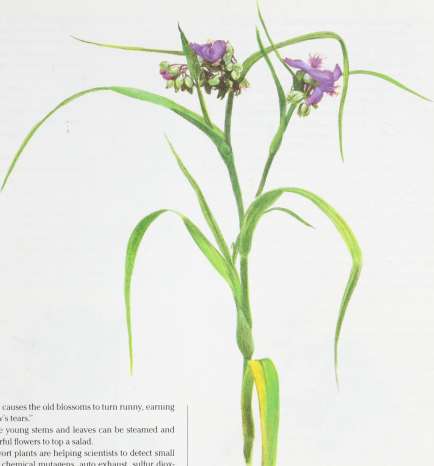
enzymatic reaction causes the old blossoms to turn runny, earning it the name “widow’s tears.”
CULINARY: The young stems and leaves can be steamed and eaten; use the colorful flowers to top a salad.
OTHER: Spiderwort plants are helping scientists to detect small levels of radiation, chemical mutagens, auto exhaust, sulfur dioxides, and pesticides. The genetically dominant blue cells in the stamens turn pink 8 to 18 days after exposure to such substances and can be seen under an ordinary microscope. In 1977, the Environmental Protection Agency (EPA) placed spiderwort plants near high-risk areas to monitor air pollution. According to spiderwort tests, petroleum refineries and mixed chemical processing plants have the highest mutation rates. In 1980, the plants detected radiation at the Trojan Nuclear Power Plant in Prescott, Oregon, and at other reactors. Dr. Sadao Ichikawa of the Saitama University in Japan found that as little as 150 millirems of radiation produce mutations. (The U.S. federal maximum level for man-made radiation is 170 millirems a year.) These occurred mostly on the windward side, only when the reactor was on. National Aeronautic and Space Association (NASA) scientists found that spiderwort is also one of the most effective plants at absorbing formaldehyde caused by poor ventilation in buildings. But before you run out to the nursery, know that you will need 70 plants for every 2 V 2 yards (2.3 m) of floor space!
Tradescantia virginiana Spiderwort
TRIGONELLA FOENUM-GRAECUM
Trigonella foenum-gmecum • Fenugreek
FAMILY: Leguminosae.
DESCRIPTION: Shrubby. Height: 2 feet (60 cm). Width: 1V 2 feet (45 cm). Flowers: Whitish, by themselves or in pairs. Leaves: Divided into 3 almost cloverlike shapes, 1 inch (2.5 cm) long, toothed around the edges. Fruit: Beaked pod, IV 2 to 2 inches (3.75 to 5 cm) long, containing 10 to 20 seeds. Blooms: June.
HABITAT: Southern Europe and Asia in open clearings. Cultivated commercially in Lebanon, Egypt, and Argentina. CULTIVATION: Annual. Germination: 2 days. Space: 12 to 18 inches (30 to 45 cm). Soil Temperature: 70° to 75° F (21 ° to 24° C). Soil: Dry and warm, or will rot. pH: 5.5 to 8.2. Sun: Full sun. Propagation: Start from seed in spring. (The seed sold at natural food stores for sprouting is suitable.)
GARDEN DESIGN: The profusion of sweetpealike flowers makes fenugreek a good garden addition. It is a legume that adds nitrogen to the soil and can be used as a cover crop to decorate and prepare new garden areas at the same time.
CONSTITUENTS: Mucilage (to 30%), alkaloids (trigonelline, gentianine, carpaine), steroidal saponins (mainly diosgenin), flavo-noids, fixed oil (8%), protein (25%), amino acids (lysine, tryptophan, leucine, histidine, arginine), lecithin, vitamins A, B,, C, minerals (calcium, iron).
HISTORY: Egyptian papyri tell of fenugreek’s use as a food and to reduce fevers, as well as an ingredient in kuphi smoke, used in fumigation and embalming. It was discovered in King Tut’s tomb (1323 B.C.). Ancient Arabic physicians used it, and a Middle Eastern greeting speaks of fenugreek, or helbah: ‘May you tread in peace on the soil where it gave new strength, and fearless mood, and gladiators, fierce and rude, helbah grows!” Fenugreek is an abbreviation of the early Latin name, foenum, “hay,” graecum, “from Greece.” It was an early fodder crop that has improved the scent of poor hay since at least the 2nd century B.c. Charlemagne ordered it grown in the 9th century and it was spread throughout Europe by Benedictine monks.
CULINARY: The seeds themselves seem to have little odor, but it increases with drying, becoming quite strong when cooked. A fenugreek extract is sold in grocery stores to give confections a maple or butterscotchlike taste. Greeks eat the seeds boiled or raw with honey; East Indians add them to curries and chutneys; and Egyptians roast them for a coffee substitute or eat the sprouts as vegetables. It is a main flavoring in the Middle East confection halvah and in breads from Arabia, Ethiopia, and Egypt. In all of these countries, including East India, the leaves are served as a vegetable. For the Ethiopians, fenugreek, or abish, is a most important food, along with beans, peas, and lentils. In North Africa, and particularly in Tunisia, the flour is used for putting on weight:
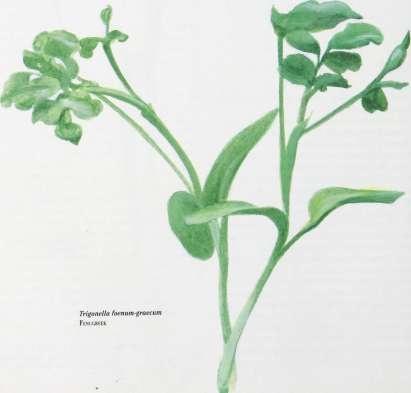
TRILLIUM E R E C T U M
3.5 ounces (100 g) of fenugreek is 25% protein, and contains 335 calories and 18 ounces (5.2 g) fat. While this may be discouraging to some people, harem women purposely ate the seeds to make them fleshier and more attractive, an indication of how fashions change! Fenugreek not only increases body weight, but also helps improve protein utilization, inhibits phosphorus secretion, and increases erythrocyte count.'
MEDICINAL: Fenugreek seeds are used in Indian and Ethiopian medicine to treat indigestion and diarrhea. Egyptians soak the seeds to make them into a thick paste that they claim is equal to quinine in preventing fevers. It is a folk remedy for diabetes, and clinical studies are proposed to support the preliminary findings that it reduces both blood sugar and cholesterol levels and delays sugar glucose transfer from the stomach to blood in animals.^ It has a stimulating and toning effect on the uterus, possibly due to its diosgenin, the same hormonelike substance found in wild yam that closely resembles the body’s own sex hormones. Fenugreek is currently being cultivated for more investigations.^ In China, it is given to men to correct impotence and to women to reduce menopausal sweating and depression and as a calcium source. Fenugreek is also used to increase male fertility, although one study shows that direct contact with it may be spermicidal.'’ The Latin Americans boil it in milk, then drink it to increase mother’s milk. A poultice has been used for rheumatic pain, burns, to draw out boils, and to relieve sore breasts.
CONSIDERATIONS: Because it stimulates the uterus, restrict use during pregnancy. The straight essential oil, similar to that of dill and parsley, can be narcotic.
OTHER: Fenugreek is still used as a flavoring in veterinary medicines, in conditioning powders for horses and cattle, and as a fodder plant. The pharmaceutical and food industries use it as an emulsifying agent. It is used as a yellow dye in India. The seeds are also planted as an agricultural cover crop.
“Maple” Pancake Syrup
cup (120 ml) fenugreek seeds 1 cup (240 ml) water V4 cup (60 ml) honey
Soak the seeds in the water for 2 hours. Bring the water to a boil and simmer about 5 minutes, until mush. Stir in honey.
Trillium erectum • Trillium
(Previously T. flavum)
FAMILY: Liliaceae.
DESCRIPTION: Height: 2 feet(60cm). Width: 10 inches(25cm). Flowers: Brown-purple, occasionally white, yellow, or green, to 2 inches (5 cm) long, almost erect on 4-inch (10-cm) stems, surrounded by leaves. Leaves: Broad, triangular. Rhizome: Dull brown, often ringed with lines, with wrinkled rootlets underneath, yellow to red-brown. Tastes sweet, then acrid. Blooms: May to June. HABITAT: Canada, through the Midwest and east coast of the United States. Found on moist soils in shaded woods.
CULTIVATION: Perennial. Zone: 2 or 3 to 7. Requires a cold winter to go dormant. Germination: 1 month. Stratify fresh seed. Space: 1 foot (30 cm). Soil Temperature: 60° to 70° F (15° to 21° C). Soil: Moist, fertile, humus. pH: 4.5 to 6.5. Sun: Partial shade. Propagation: By seed or root division. The first year from seed produces only 1 leaf. It takes 3 to 4 years to produce flowers from seed. Very hardy once established, except in hot climates. Makes a suitable potted herb and can be forced for winter flowers indoors. GARDEN DESIGN: Very striking, especially when in bloom. Plant where larger herbs won’t overshadow it. It contrasts well with other spring wildflowers, such as bloodroot. Be forewarned; flies pollinate the rancid-smelling flowers, so you may not want a patch of trilliums under a window.
CONSTITUENTS: Steroidal saponins(diosgenin), essential oil. RELATED SPECIES: There are other species of trillium, including the most popular, white-flowering trillium (T. grandi-florum), with fragrant, large flowers.
HISTORY: Trillium’s name describes its 3 (tri) distinct petals, 3 sepals, and 3 leaves. When introduced in 1830 by Rafinesque, any species was used medicinally, although the Native Americans regarded the white-flowering trilliums most effective. Then, in 1892, Charles Millspaugh declared that only T. erectum should be used. Many species were actually grouped together and classified as T. pendulum (a name no longer used) by wildcrafters. Called wake-robin, it is said to wake the robins into song as it pushes through the last snowdrifts in early spring.
MEDICINA L: The trillium rhizome is used mostly for menstrual disorders, such as relieving cramps and excessive flow, and for vaginal infections. It was an ingredient in the Compound Elixir of Viburnum Opulus (cramp bark), which was used for similar women’s complaints. Trillium is also used after childbirth to stop bleeding, which gave it the common name birth root, or beth root. The diosgenin it contains (which also occurs in wild yam root [Diosco-rea uillosaj) is related to human sex hormones and to cortisone. As an external astringent, it can be applied to wounds, ulcers, and sores and used to treat chronic skin infections. Taken internally, it stops digestive tract bleeding and is included in diarrhea and dysentery treatments. It is also used to relieve lung congestion.
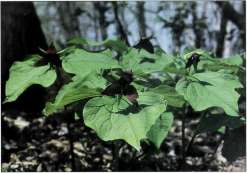
Trillium erectum. Trillium catches the eye with its significant three petals borne above three distinct leaves.
195
© Steven Foster
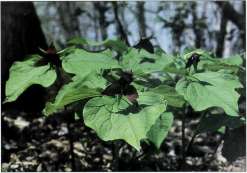
TROPAEOLUM M A J U S
t
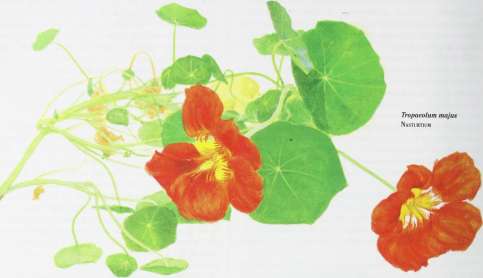
Tropaeolum majus • Nasturtium
FAMILY: Tropaeol iceae.
DESCRIPTION : Climbing or trailing vine. Length: 5 to 10 feet (1.5 to 3 m). Flowers: Broad petals, 2V2 inches (6.25 cm) across, yellow, orange, or red and sometimes spotted, funnel-shaped, with long spur in back. Leaves: Almost round, slightly ruffled, 2 to 7 inches (5 to 17.5 cm) across, thin, slightly succulent. Fruit: Globelike seedpods filled with many seeds. Blooms: Throughout the summer, most of the year in warm climates.
HABITA T: Native to the Andes in South America. CULTIVATION: Annual. Germination: 7 to 10days. Fresh seed is best. Needs darkness to germinate. Space: 1 foot (30 cm). Soil Temperature: 65° F (18° C). Soil: Well drained, slightly sandy, average-will produce less flowers if too moist or rich. pH: 7.5 to 8.5. Sun: Full sun in cool climate or partial shade in hot climate. Propagation: From seed. Flowers 8 weeks after germination. Best in cool conditions and will bloom in the winter in warm climates. GARDEN DESIGN: The brightly colored flowers are a popular ornamental in flower gardens. They can climb up a wall or fence, hang from a pot, or become a rapid groundcover. Place them so they won’t detract from small herbal flowers. Watch out! It may attract aphids during hot weather.
CONSTITUENTS: Glycoside (glucotrapaeoline), which hydrolyzes to antibiotic and antifungal sulfur compounds and an essential oil, isothiocyanate (or mustard oil); high vitamin C content in flowers and leaves.
RELATED SPECIES: The dwarf (T. minus) scrambles more than climbs. T. tuberosum is an important vegetable in its native Andes.
HISTORY: Introduced to Spain by conquistadores in the early 17th century, nasturtium was called Indian cress and promoted as a vegetable and medicine. It was originally placed in the same family as watercress. Calling it yellow lark’s heel because of the flower’s spur, in 1629 John Parkinson suggested that the fragrant nasturtium could be combined with carnations and clove pinks “to make a delicate tussie-mussie,... or nosegay, both for sight and sent.” CU LIN ARY: The flowers and especially the buds are pickled as a caper substitute. The fresh leaves and flowers are eaten in salads and sandwiches, much like lettuce, but in smaller amounts. Any part of the plant can be whipped with warmed butter into a tasty “nasturtium butter” to spread on crackers or bread. MEDICINAL: Nasturtium flowers and leaves contain a natural antibiotic that doesn’t interfere with intestinal flora—it is even effective against some microorganisms that have built up resistance to common antibiotics. The leaves are eaten or made into tea for both the reproductive and genitourinary tract and respiratory infections. It is reputed to promote red blood cell production. The juice of the fresh plant has been rubbed on itching skin.
CONSIDER AT IONS: Large amounts of the seeds are purgative. OTHER: Has been fed to chickens to prevent and cure fowl pox.
TUSSILAGO F A R F A R A
Nasturtium Capers
This recipe was adapted from The British Housewife, written in 1770 by Martha Bradley. Of the initial cooking process of the buds, she wrote, “They will fade a little, and they will soon be as dry as when just gathered; and being thus faded they will take the vinegar better than if they had been quite fresh.” If you are patient and let them sit 6 weeks, “In that Time the Vinegar will have penetrated them thoroughly and the Taste of the Spices will be got into their very Substance, so that they will be one of the finest Pickles in the World,” promised Bradley. ‘
Nasturtium buds to fill a 1-quart (I-l) jar 1 quart (11) vinegar ’/4 teaspoon (1.25 ml) nutmeg V 2 teaspoon (2.5 ml) black pepper, whole 6 cloves
Stir buds in cold water, drain, and repeat, then lay on a sieve to dry. Loosely fill a well-washed quart (litre) jar with buds, sprinkling in spices as you go. Fill the jar with vinegar and put on a lid. Let sit 6 weeks before opening.
Latin Chicheghi Salatassi (Nasturtium Salad)
Here is a recipe from the Turkish Cookery Book of 1862 by Turab Effendi.
Put a plate of flowers of the nasturtium in a salad-bowl, with a tablespoon of chopped chervil; sprinkle over with your fingers half a teaspoonful of salt, two or three tablespoons of olive oil, and the juice of a lemon; turn the salad in the bowl with a spoon and fork until well mixed, and serve.
The Indian cress our climate now do’s bear,
Calld Larksheel ’cause he wears a horse-man’s spur.
This gilt-spun knight prepares his course to run Taking his signal from the rising sun,
And stimulates his flow 'r to meet the day So Castor mounted spurs his steed away This warrior sure has in some battle been For spots of blood upon his breast are seen.
—Abraham Cowley (1618-1667), English
Tussilago farfara • Coltsfoot
FAMILY: Compositae.
DESCRIPTION: Low-growing and spreading. Height 4 to 8 inches (10 to 20 cm). Width: 6 inches (15 cm). Flowers: Bright yellow, 1 inch (2.5 cm), resemble dandelions, but held aloft on purplish, scaly, 8-inch (20-cm) stems. Turn into white tufted seed heads. Leaves: Slightly lobed and toothed around the edge. Dull green, flat with a downy white underside, 4 to 7 inches (10 to 17.5 cm) wide. They appear in late spring, long after the flowers. Mucilaginous and somewhat bitter-tasting. Blooms: March to April. HABITA T: Native to Europe, northern and western Asia, northern Africa; naturalized in other areas, including the northeastern United States, in moist, loamy soils of wastelands.
CULTIVATION: Perennial. Zone: 2. Germination: 1 to2 weeks. Space: 6 to 8 inches (15 to 20 cm). Soil Temperature: 60° to 70° F (15° to 21° C). Soil: Heavy, rich loam that holds moisture. Will grow in poor conditions, but develops more bitterness. pH: 4.5 to 7.5. Sun: Sun or partial shade. Propagation: Grow from seed or divisions. Once established, it will happily take over the garden if not restrained; 3 to 6 cuttings a year are possible.
CONSTITUENTS: Flavonoids(rutin, hyperoside, isoquercetin), polysaccharide mucilage (8%), pyrrolizidine alkaloids, sterols, essential oil, minerals (potassium, calcium salts), tannin, inulin. RELATED SPECIES: Coltsfoot is often confused with western coltsfoot (Petasites spp.), a much larger herb used for lung congestion that grows wild in the northwest United States. They have similar medicinal uses.
HISTORY: The ancients imagined that the outline of coltsfoot leaves resembles a colt’s footprint. The Romans called it Filius ante patrem, “the son before the father,” because the flowers appear and wither in the spring before the leaves emerge. For the same reason, the Russians call it mat i matcheha, or “mother and stepmother.” In Pliny’s day (the 1st century A.D.), Romans inhaled smoke from coltsfoot leaves burnt on cypress charcoal through a reed, then sipped wine, to stop obstinate coughing. For centuries, it was a popular ingredient in herbal tobaccos and is still the main ingredient in “British Herb Tobacco” (with buckbean, eyebright, betony, rosemary, thyme, lavender, and chamomile). In the past, a picture of the coltsfoot flower painted on the doorpost identified French pharmacies.
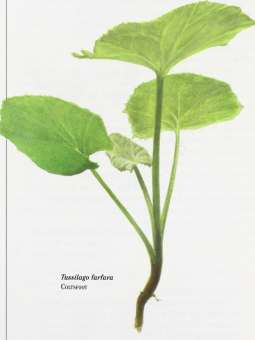
<S> Kathi Kevilie
Urtica dioica • Nettle
U R T I C A DIOICA
*
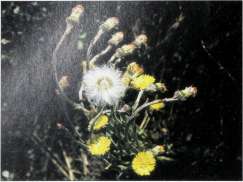
Tussilago farfara. The unusual characteristic of coltsfoot flowers is that they appear before the leaves, signaling the early days of spring.
CULINARY: The leaves were eaten as a vegetable and the flowers were once used to flavor wine.
MEDICINAL: Herbalists, from Dioscorides in the 1st century to present-day practitioners, have recommended coltsfoot leaves for lung problems such as laryngitis, bronchitis, and asthma, and to control spastic coughing. It is a soothing expectorant, and the flavo-noids it contains reduce inflammation, especially in the bronchials. Even its name Tussilago comes from tussis, Latin for “cough.” Coltsfoot is also applied as a poultice to sores and ulcerations and as a cream for cold sores.
CONSIDER AT IONS: Coltsfoot contains traces of pyrrolizidine alkaloids (PA) (similar but not identical to those in comfrey root), and the jury is still out concerning its safety. The alkaloids cause liver toxicity in rats fed high daily doses, although not those given low doses.' More encouraging studies show that the immune systems of mice were stimulated when the animals were given an extract made from the whole plant.^ So far, the alkaloids have not been shown to cause any damage to human chromosomes in the test tube.^ A 1987 case reported an infant born with severe liver injury after her mother had consumed coltsfoot tea daily for a lung problem, but the tea was later proven to be adulterated with Petasi-tes, which contains much higher concentrations of PA. The early evidence in this case prompted Germany to ban 2,500 products containing herbs with PA in January 1089. They propose restricting coltsfoot to about 1 teaspoon of dried herb, 6 grams, or 1 microgram of PA daily for no more than 4 weeks.
OTHER: The feathery seed heads were once collected for pillow stuffing.
Coltsfoot’s a classical fixture In one old smoking mixture.
Some say after heating The leave’s fit for eating,
But that s a debatable issue.
— “Coltsfoot. ’’ James A. Duke (b. 1929), American
FAMILY: Urticaceae.
DESCRIPTION : Bristly herb with few branches. Height: 3 to 6 feet (.9 to 1.83 m). Width: 2 to 3 feet (60 to 90 cm). Flowers: Small, white, loosely clustered. Leaves: Oval, coming to a point, deeply serrated around edge, downy, covered with stinging hairs, to 6 inches (15 cm). Even slight pressure releases fluid from a capsule at the base of each hollow stinger hair. Blooms: June to September.
HABITAT: Eurasia, naturalized elsewhere, including Australia. CULTIVATION: Perennial. Zone: 2. Germination: 10 to 14 days. Space: 1 to 2 feet (30 to 60 cm). Soil Temperature: 65° to 75° F (18° to 24° C). Soil: Damp, rich with nitrogen. pH: 6.5 to 7.5. Sun: Full sun or partial shade. Propagation: By seed, cuttings, or root division. Likes to grow by running water.
GARDEN DESIGN: It might be wise to place nettle beyond reach of visitors in the garden, who may injure themselves touching and smelling the herbs.
CONSTITUENTS: Formic acid, which causes the painful reaction, found in hairs; indoles (histamine, serotonin); acetylcholine; minerals (iron, silica, potassium, manganese, sulphur); vitamins A, C; especially high in chlorophyll.
HISTORY: Nettles have supplied fiber for cloth and paper from the Bronze Age (4,000-3,000 B.c.) into the 20th century. The name is derived from the Anglo-Saxon netel, which some authorities think originated from noedl (a needle) because of its stingers. More likely, it comes from net, akin to the Latin fishnet, nassa, which was made out of nettles. Roman soldiers in Britain planted urtica, from urere, meaning “to sting,” to rub on their limbs so they could better tolerate the cold winter (probably U. pilulifera). Later, it was cultivated in Scotland, Denmark, and Norway to make fine linen, coarse sailcloth, and strong fishnets. Eventually, flax was preferred, but nettles were still used to weave coarse household cloths, called scotchcloth, from the 16th through the 19th centuries. Scottish poet Thomas Campbell (1777 to 1844) related.
In Scotland, / have eaten nettles, / have slept In nettle sheets, and / have dined off a nettle tablecloth. The young and tender nettle is an excellent potherb,... I have heard my mother say that she thought nettle cloth more durable than any other species of linen.
To make cloth, the nettles were cut, dried, and steeped in water, then the fibers were separated and spun into yarn. In the Hans Christian Anderson (1805-1875) fairy tale The Princess and the Eleven Swans, the coats the princess made for her brothers were woven from nettle. In Les Mis'erables, the character Monsieur Madeleine describes its virtues:
When the nettle is young, its leaf forms an excellent vegetable; when it matures, it has filaments and fibres like hemp and flax. Nettle fabric is as good as canvas. Chopped, the nettle Is good for poultry; pounded it is good for cattle. The seed of the nettle mingled with fodder imparts a gloss to the coats of animals; its root mixed with salt produces a beautiful yellow color. It is besides excellent hay and can be cut twice. And what does the nettle require: Little earth, no attention, no cultivation. Only the seed falls as it ripens, and is difficult to gather. That is all. With a little trouble, the nettle would be useful; it is neglected, and becomes harmful —LesMiskRABLES. Victor Hugo (1802-1885). French
198
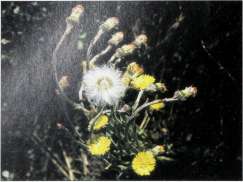
U R T I C A D I 0 I C A
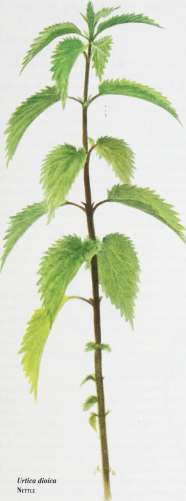
CU LIN ARY: When cooked or dried for winter use, nettles lose their sting. The young, steamed tops taste somewhat like spinach. Nettle porridge was popular in the 17th century, and nettles were the Roman Pliny’s favorite pudding. The Scots still make nettle pudding with leeks, broccoli, and rice. Italians make herb knodel by cooking nettles like dumplings. The Russians serve stchi, often called “green borscht,” with stuffed eggs. Cheese makers use it as a rennet substitute. (One cup of strong tea is made and mixed with Vs cup [80 ml] salt, and 1 tablespoon [15 ml] is added to 2 pints [11] of milk.) I’ve found it doesn’t coagulate milk as solidly, but does make a fine soft cheese. Australian Aborigines ate native nettle leaves after baking them between heated stones.
MEDICINAL: Nettle leaves are a blood builder often used as a spring tonic and to treat anemia and poor circulation. They contain both iron and vitamin C, which aids iron absorption. In the past, nettle was eaten or sipped to reduce uric acid and to treat gout and arthritis. I’ve even observed arthritics directly hitting stinging nettles on joints to relieve their pain. They considered the sting minor compared to the temporary relief it provided. Nettle also encourages mother’s milk, lowers blood sugar, and decreases profuse menstruation; it acts as a light laxative and diuretic. Both a tea and a poultice (of cooked nettles) are used to treat eczema and other skin conditions. An astringent that stops bleeding, the powder is snuffed to stop nosebleeds. Curled dock leaves (Rumex crispus), another widespread weed, provide a remedy for nettle’s sting. “Nettle in, dock out, dock rub nettle out!” goes an old rhyme. Interestingly, the fresh juice of nettles themselves relieves the sting. Australia’s Aborigines are said to have used a nettle (U. incisa) lotion for sprains, and to have boiled leaves for a poultice. COSMETIC: Nettles are found in hair conditioners and shampoos. They are said to promote hair growth when applied to the scalp, although they are probably more helpful when taken internally.
CONSIDERATIONS: Wear gloves when picking.
OTHER: Nettles are a source of commercial chlorophyll. Biodynamic gardeners use them as compost starter to activate the compost pile. The plants are also said to increase the essential oil content of nearby herb plants. Swedish studies at the University of Lund show that a strong water extract of either dried or fresh nettles (especially spring-harvested) poured on plants stimulates their growth. It makes a permanent green dye on wool or yellow with alum. Ukra-nians use nettles to dye Easter eggs with their elaborate batik designs and as a green confection dye. Nettles are also added to animal feed to increase the milk production and health of farm animals.
Nettle Pudding
1 gallon (4.51)young nettle tops
2 leeks or onions
2 heads broccoli or small cabbage ’/4 pound (113 g) rice 1 teaspoon (5 ml) salt
Combine ingredients. Boil or cook in a pressure cooker until rice is done. Serve with gravy or melted butter.
Stchi
The following was adapted from The Epicure in Imperial Russia written by Marie Alexandre Markevitch and published in 1941.
1 pound (500 g) young, fresh nettle shoots cup (120 ml) cream 1 quart (11) bouillon
Steam or boil nettles, and chop finely. Let cool. Mix in cream and bouillon and bring to a boil.
If they would drink Nettles in March,
And eat Mugwort in May,
So many fine maidens Wouldn't go to the clay.
—“Proverbs,” Michael Denham, English
V A C C I N I U M MYRTILLUS
i
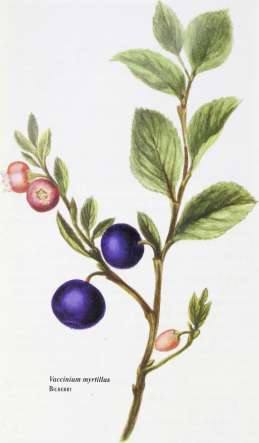
Vaccinium myrtillus Bilberry
Vaccinium myrtillus • Bilberry
FAMILY: Ericacea.
DESCRIPTION: Ornamental, deciduous shrub that turns yellow-green, then red in the fall. Height: 1 to 2 feet (30 to 60 cm). Width: 3 to 4 feet (90 to 120 cm). Flowers: Pale, green-pink, Vi inch (.63 cm), and solitary. Leaves: Shiny, leathery, bright green, finely dented around the edges, oval, 1 inch (2.5 cm) long. Fruit: Resembles currants, slightly acid, globe-shaped, V:j inch (8 mm) in diameter, purple. Root: Thin, creeping. Blooms: May to August.
HABITAT: Europe, northern Asia, and North America, from British Columbia south to New Mexico. Found mostly in damp woodlands and moorlands.
CULTIVATION: Perennial. Zone: 5. Space: 2 feet (60 cm). Soil Temperature: 65° to 75° F (18° to 23° C). Soil: Damp, peaty with humus, moist. Plenty of water but not standing. pH: 4 to 5. Sun: Filtered shade. Propagation: From rooted cuttings.
GARDEN DESIGN: The bilberry gives the garden height or defines the outlying edges. It adds a colorful touch to the autumn garden when many of the herbs have ceased flowering. CONSTITUENTS: Fruit: anthocyanin, responsible for the fruit’s blue color (at least 0.3%); alkaloids (myrtine, epimyrtine); glycosides (quercitrin); tannins (to 1%), organic acids; pectin; sugar; vitamins A and C. Leaves: glucoquinine.
HISTORY: The genus contains about 150 species with the common names interchanged so often, no one is sure which berries the older writings refer to when they mention Vaccinum, the name used by the Roman Pliny. We do know bilberry was a medicinal herb in the 16th century. It is a good chance that they are the “black whortles” Gerard described as eaten with cream by the people of Cheshire in the 17th century. The English are still calling them whortleberries—and eating them with cream. The Scots know them as blaeberries. The American name bilberry came from the Danish bollebar, or "dark berry.” In the United States, they are also called huckleberries.
CULINARY: A favorite way to prepare bilberries has been to stew them with lemon and sugar. The small size of the seeds makes them ideal for jams, syrups, and conserves. They have been added to liqueurs and wines to make them seem richer and more aged. MEDICINAL: A drink of the fruit and roots steeped in gin is an old remedy to stop diarrhea and relieve nausea and indigestion — although, as with blackberries, large amounts of the whole berries eaten with their pips (seeds) and skin provide a laxative bulk. They can decrease intestinal inflammation and help protect the digestive tract lining. The berries are also said to be a refrigerant that lowers body heat. Studies show an effect on heart contractions and blood vessels that is thought to be caused by the berries stimulating the production of prostaglandins.' There is evidence that they also help prevent blood clots. Bilberries are incorporated into European pharmaceuticals that are used to improve circulation and night vision. Several scientific studies support this use. In Russia, berries and leaves are used to treat colitis, stomach problems, and sugar diabetes. The leaves are also found, along with related species, in folk remedies of other countries to treat diabetes. The glucoquinine in the leaves does show a weak ability to lower blood sugar. Clinical studies have been proposed to back the hypoglycemic effects found in animals.' German researchers have also suggested that the quinic acid produced from a tea of dried bilberry leaves is a potential treatment for rheumatism and gout.
OTHER: The berries produce a blue-purple dye (with alum) and other colors. They were used in Norway to treat scurvy.
VALERIANA OFFICINALIS
Valeriana officinalis • Valerian
(Previously V. excelsa)
FA MIL Y: Valerianaceae.
DESCRIPTION : Leafy herb with tall, hollow, flowering stalk. Height; 5 feet (1.5 m). Width: 1 foot (30 cm). Flowers: White, pink, or lavender; fragrant; to Vie inches (4 mm). Leaves; Very divided into 7 to 10 segments. Roots: Their smell has often been compared to dirty socks. Blooms: May to July.
HABITAT: Europe and western Asia. Naturalized in Canada and northern United States, in low meadows and wet woods. CULTIVATION : Perennial. Zone: 4. Germination: To 3 weeks. Space: 1 foot (30 cm). Soil: Moist. pH: 6 to 7. Soil Temperature: 60° to 70° F (15° to 21° C). Sun: Full sun or partial shade. Propagation: By seed or root division. It is difficult to remove once established. The root can be harvested by the autumn of the second year. Some gardeners take the flowers off young plants to hasten root development.
GARDEN DESIGN: Valerian looks best when its flowers begin to gracefully sway on their tall stalks. It goes well towards the back of the garden, where it will happily grow in tight clumps. CONSTITUENTS: Iridoids called valepotriates (to 2%); glycoside (valerosidatum); essential oil (to 2%) includes esters of acetic, butyric, and isovalerianic acids, which yield isovalerianic acid when dried, giving valerian its distinct aroma; sesquiterpene; alkaloids. In 1907, researcher Chevalier stated that fresh valerian is more active than the dried root.
RELATED SPECIES: Native American species have similar properties. Indian valerian (V. wallichii) contains four times the valepotriates (0.5%).' The sedative Himalayan valerian (Nardos-tachys jatamansi, formerly V. Jatamansi) is thought to be the fragrant spikenard, or “nard,” of the Bible that is still used in East India to scent clothing and ointments. Red valerian, or Jupiter’s beard, (Centmnthus ruber, previously V. coccinea) is a very different plant. Valerian is sometimes called “garden heliotrope” because its flowers resemble the unrelated, sub-tropical Heliotropium arborescens.
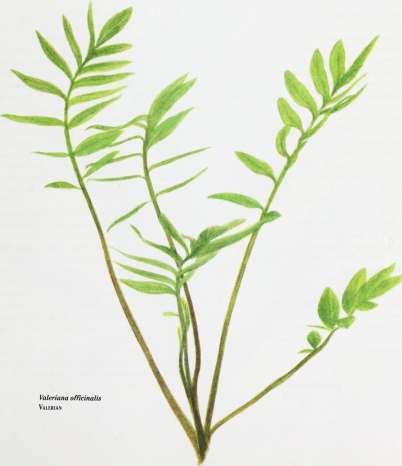
VERBASCUM T H A P S U S
i
HISTORY: The Roman name valere was derived from valor for courage—which might describe the strength needed to drink the strong-tasting brew. Galen and Dioscorides called valerian phu— another descriptive response to its odor! (This species is designated Phu.)The 11th century Anglo-Saxon “leech” books describe it, as does Saladinus of Ascoli, founder of Salernum Medical School (c. 1450). In modern history, valerian was prescribed in England for enduring World War II air-raids.
CULINARY: As strong as it may be, valerian was used as a spice in the Middle Ages and the leaves were used as Anglo-Saxon salad herbs. Gerard mentioned the esteem in which the 16th century Scots held valerian, noting that “no broth or pottage...be worth anything if setewale be not there.”
MEDICINAL: Valerian root is a general tranquilizer used for relieving nervous tension, insomnia, and headaches. Widely studied. it has been shown to sedate the central nervous system due to the valepotriates and other components found in the essential oil.^ Valerian decreases muscle spasms, so is useful for cases of nervous digestion, irritable bowel syndrome, and stomach or menstrual cramps. It contains many types of valepotriates that have opposing effects, indicating that it has the ability to regulate many conditions. In one study, it sedated agitated patients, but stimulated those suffering from fatigue.^ Valerian improved the quality of sleep in subjects in another study, as observed in their brain-wave patterns. It also reduced the time it took them to fall asleep, especially the elderly and the habitually poor sleepers, but did not affect their dream recall or ability to wake up in the morning.'* In Germany, hyperactive children have been treated with valerian since the 1970s. After taking valerian for only a few weeks, 120 children diagnosed as hyperactive, anxious, or learning disabled had better muscle coordination and reaction time, and showed less aggression, restlessness, anxiety, and fear.^ Valerian may also lower blood pressure and strengthen the optic nerve in the eye, although thus far, only animal studies have been done.®
AROMATHERAPY: The essential oil of valerian is closely related to whale and porpoise oil and oxidized animal fats and secretions. This may not make it seem a contender for aromatherapy, but very minute amounts actually produce pleasing scents for soap and after-shave fragrances. The roots were used in the 17th and 18th centuries to scent clothing.
CONSIDERA TIONS: Valerian is reported to cause headaches, muscle spasms, and heart palpitations in very large or prolonged doses, although no other adverse effects in humans have been documented.^ It can also increase certain effects of alcohol. Avoid during pregnancy.
OTHER: The root excites some animals, especially rats and cats, but they usually won’t know it is in your garden unless it is uprooted. It is rumored that the famous Pied Piper of Hamelin owed his success in leading the rats out of the city to having had his pockets stuffed full of valerian rather than to his music! Valerian is still used by rat catchers.
Verbascum thapsus • Mullein
FAMILY: Scrophulariaceae.
DESCRIPTION: Height: To 6 feet (1.8 m). Width: 2 to 3 feet (60 to 90 cm). Flowers: Yellow, 1 inch (2.5 cm) across, 4 petals, clustered densely around single flower spike. Sometimes smaller side spikes. Leaves: Large ovals,to2 feet(60cm)long, thick, and covered with fine, somewhat prickly hairs. They form a rosette, from which flower stalk grows. Blooms: July to August, 2nd year.
HABITA T: Europe and Asia, and naturalized extensively in the United States and Australia, on stony wastelands and cleared areas. C ULTIVATIO N: Biennial. Zone: 3. Germination: 15 to 12 days. Space: 2 to 3 feet (60 to 90 cm). Soil Temperature: 60° to 70° F (15° to 21° C). Soil: Dry, well drained, slightly poor. pH: 5.5-7.5. Sun: Full sun*. Propagation: By seed, self-sows easily, especially in good garden soil.
GARDEN DESIGN: Mullein stands out in the garden, especially when in bloom. Since only a single flower stalk gives it height, it is best suited in the middle among other low-growing herbs. CONSTITUENTS: Saponins, essential oil, flavonoids, glycosides (acubin), mucilage.
RELATED SPECIES: V. bombyciferum, with its very white, fuzzy leaves and large flowers, is often grown as an ornamental herb. Various species are medicinal, especially V. thapsiforme and V. phlomoides. Saponins contained in their seeds stupefy fish and are used to catch them; they also eliminate tapeworms. HISTORY: The Romans called mullein verbascum, probably from the Latin barba, or “beard,” and the name mullein must have originated with the latin mollis, or “soft.” Both describe its fuzzy leaves. Dr. Prior, in his The Popular Names of British Plants, thinks that mullein’s name was derived from the Latin malandrium, or “malady.” Whatever the case, it later became the Anglo-Saxon motegn. When in flower, it looks like a large candle; in fact, the flowers dipped into tallow and lit make a primitive torch, giving it the name haege or hage (hedge) taper, sometimes confusingly turned into “hag’s” taper! Parkinson reports that such candles were called Latines Candela Regia and carried during ceremonies, especially funerals.
MEDICINA L: Mullein is one of the primary herbs for any lung problem, including whooping cough, asthma, bronchitis, and chest colds. It was traditionally smoked for lung conditions. It is also a diuretic used to relieve urinary tract inflammation, diarrhea, and inflammation, colitis, or other bleeding in the bowel. The flowers extracted into olive oil make a preparation that is well known to reduce the pain and inflammation of earache, insect bites, bruises, hemorrhoids, and sore joints. A distilled flower water or a poultice has been placed on burns, ringworm, boils, and sores. CONSIDERATIONS: The fine hairs irritate some people’s skin, producing rashes, a warning for those who wish to use the leaves as “natural toilet paper.”
OTHER: The flowers make a pale yellow dye. Roman women took advantage of this to bring out light highlights in their hair. The ashes were once made into soap for a hair tonic.
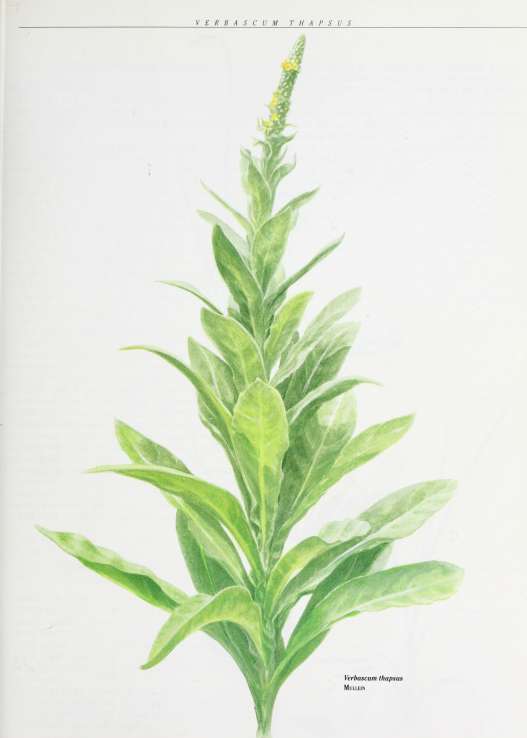

V E T I V E R I A ZIZANIOIDES
Verbena officinalis • Vervain
FAMILY: Verbenaceae.
DESCRIPTION: Erect, stiff herb. Height: 4 to 5 feet (1.2 to 1.5 m). Width: 2 feet (60 cm). Flowers: Small, vivid blue, rising on spikes. Leaves: Oblong, to 6 inches (15 cm), edges slightly serrated. Blooms: May to June.
HABITAT: Europe, naturalized in Australia.
CULTIVATION: Perennial. Zone: 4 to 5. Germination: 3 to 4 weeks. Needs dark to germinate. Space: 1 foot (30 cm). Soil Temperature: 70° to 75° F (21° to 23° C). Soil: Light, well-drained. Sun: Full sun. Propagation: By seed, cuttings, or root division. GARDEN DESIGN: Vervain is a tall, stately herb that fits well in a mixed border of herbs, andiorms a nice backdrop for other plants. CONSTITUENTS: Glycosides(verbenalin, verbenin), alkaloid, bitter principle, essential oil.
RELATED SPECIES: Garden verbena fV x hybrida) Includes many fragrant and colorful cultivars. The older species were used in perfumery, but the scent has been hybridized out.
HISTORY: The name vervain is often said to have come from the Celtic ferfaen, or fer, meaning “to drive away,” and faen, “a stone,” from its function of eliminating bladder stones. More likely, it was derived from the Latin verbena, meaning “a shoot or green branch,” also the Latin generic term for an altar plant. Romans not only adorned altars, but also decorated peace messengers with vervain, and they believed it could rekindle dying love. Vervain was also a magic plant in Celtic and Germanic cultures. It became known as herba sacra and herba veneris in the early church. MEDICINA L: In previous centuries, vervain leaves were used to treat autumn fevers. They were found in formulas for liver and gall bladder problems and chronic skin conditions. Vervain leaves were a traditional remedy for uterine cramping, and the glycosides they contain do show evidence of promoting menstruation and increasing mother’s milk.' Vervain is made into a mouthwash for infected gums and a poultice for hemorrhoids or wounds. A tea has been used as a nerve tonic, to treat insomnia, and as a digestive. Vervain is also used in home-made liqueurs. South American, Mexican, and Chinese folk medicines suggest vervain tea for treating various growths and cancers, particularly of the neck, spleen, and scrotum. CONSIDERATIONS: Avoid during pregnancy.
Vetiveria zizanioides • Vetiver
(Previously Andropogon zizaknioides)
FAMILY: Gramineae
HABITAT: Found in tropical India, cultivated throughout the tropical world and in parts of Louisiana.
DESCRIPTION: Large, bushy grass. Height: 7 to 8 feet (2.1 to 2.4 m). Flowers: Only the northern “khus” type blooms, in pairs on 6 to 12 stems. Leaves: Long, thin, pointed with sharp edges. Vie inches (8 mm) wide. Roots: Thin, spindly, brown, richly scented when broken.
CULTIVATION: Perennial. Zone: 9. Space: 2 to 3 feet (60 to 90 cm). Soil: Dry, well-drained, fairly poor soil is suitable. Sun: Full sun. Propagation: By root division of clumps. Sufficient phosphorus and potash increase oil yield.
GARDEN DESIGN: Somewhat lacking in design qualities, vetiver is best as a thick backing or filler, or used as a hedge plant. CONSTITUENTS: Essential oil includes at least 29 different compounds.
HISTORY: Vetiver has been used for centuries as incense and perfume. The name is derived from the Tamil vetivern. East Indians differentiate the cultivated “vetiver” from the wild “khus” of northern India, which flowers and has a slightly different chemistry. MEDICINAL: Vetiver roots are occasionally taken as a stimulating tonic drink in India. They are used to improve digestion, encourage menstruation, and kill parasites. It is said to have a “cooling” effect on the body and to increase sweating. East Indians treat fevers, flus, and rheumatism with it.
AROMATHERAPY: Vetiver is one of India’s main essential oil crops. The long roots are woven into fragrant window blinds and floor mats. On hot days, water is thrown on them so the wind releases their scent. According to Guenther, in The Essential Oils, the roots are at peak oil production when two years old, but tests at the Lemongrass Research Station on Odakkali, India, indicate that 18 months is the preferred age. Guenther also states that vetiver oil is “...one of the most valuable and most important perfumers’ raw materials.”
OTHER: Haitians make thatch from vetiver. Fans and baskets woven from the roots are sold in import stores.
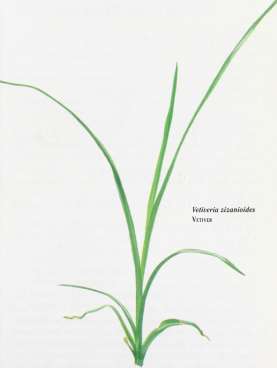
VIBURNUM 0 P U L U S
t
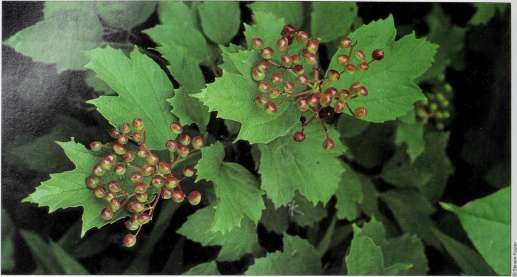
Viburnum opulus • Cramp Bark
FAMILY: Caprifol iaceae.
DESCRIPTION : Large, deciduous bush with spreading branches. Height; To 12 feet (3.6 m). Width: 6 feet (1.8 m). Flowers: Small, white, form large semicircular balls 3 to 4 inches (7.5 to 10 cm) across. Leaves; Maplelike with 3 to 5 lobes, hairy underneath. Fruit: Scarlet, then purple, drooping. Blooms: May to July.
HABITAT: A native of Europe, northern Africa, and northern Asia, grown ornamentally in the United States, where it sometimes escapes from cultivation. Popular in Australian gardens. CULTIVATION: Perennial.Zone:3.Germination:3to8months. Space: 4 to 5 feet (1.2 to 1.5 m). Soil Temperature: 70° F (21° C). Stratify in refrigerator 3 months, then 70° F (21° C) for 1 to 2 months. Soil: Heavy, somewhat rich, loamy, moist. pH; 6 to 8. Sun: Full sun. Propagation: From seed, hardwood cuttings, or bareroot trees planted in the fall.
CONSTITUENTS: Tannins, isovalerianic acid, resin (iburnine), salicosides.
RELATED SPECIES: The American cranberry bush (V. trilo-bum) is almost identical. Other, similar species from the eastern United States are used medicinally, including; possum haw (V. nudum), southern black haw (V. nifidulum), and black haw (V. prunifoliurn). Nurseries most often sell the snowball bush (U opulus ‘Roseum’), which produces sterile seeds.
HISTORY: In Europe, cramp bark has been mostly a Polish and Romanian folk medicine, although Chaucer (1340-1400) did note that the “gaitre-beries shal be for your hele.” The various American species were used by the natives and adapted into many patent remedies sold in 19th-century America. Cramp bark was first described by John King as a uterine tonic that prevented hemorrhaging. It remained official in the U.S. Pharmacopoeia from 1882
until 1926. It is often called “snowball tree” because of its round, white flower clusters. An older name, guelder rose or rose de Gueldre, probably came from its associations with the Dutch province Gulderland.
CULINARY: Yet another common name is cranberry tree, because the cooked fruits have been eaten, even though they are bitter. The Scandinavians and Siberians prepare a liqueur and a honey paste from the fruit.
MEDICINAL: Cramp bark’s name well describes its uses. The bark lessens the chance of miscarriage and decreases muscle cramps, especially painful menstruation. It has been shown to be a uterine and nervous system tonic and relaxant.' Other effects include relieving asthma, hysteria, convulsions, heart palpitations, and rheumatism. In Russia, the berries are made into a brandy called nastoika, a peptic ulcer remedy. The Japanese make a vinegar extract from the berries for treating cirrhosis of the liver, and the Chinese use both the leaves and berries as an emetic and laxative. CONSIDERATIONS: The uncooked berries are potentially poisonous and can cause indigestion even when taken in small amounts.
OTHER: The berries, which turn black when dried, are a fabric dye and were once used to make ink.
Sweet is the air with budding haws, and the valley stretching for miles below
Is white with blossoming cherry trees, as if Just covered with the lightest snow.
—Golden Legend. Henry Wadsworth Longfellow ( 1807 1882 ), American
What is sweeter, after all
Than black haws, in early fall?
—James Whitcomb Riley ( 1849 1916 ), American
206
Steven Foster
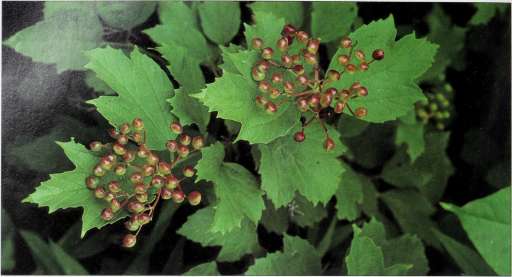
VIOLA 0 D 0 R A T A
Viola odorata • Violet
FAMILY: Violaceae.
HA BITA T: Europe, Africa, and Asia.
DESCRIPTION: Low-growing groundcover, growing on a creeping rhizome. Height: 4 inches (10 cm). Flowers: V4-inch (2-cm) across, deep violet, occasionally rose or white, drooping, with a short spur in back, sweetly scented. These rarely set seed, but a second set of smaller, autumn flowers do. Leaves: Heart-shaped and slightly toothed around the edges. Roots: Thin, brown, in a creeping network. Blooms: February to April. CULTIVATION: Perennial. Zone: 5 to 6. Germination: 10 to 20 days. Stratify. Needs dark to germinate. Space: 6 to 8 inches (15 to 20 cm). Soil Temperature: 70° F (21° C). Soil: Rich. pH: 7 to 8. Sun: Full sun. Partial shade in very hot climates. Propagation: By seed or root division. The easiest method is to remove off-shoots in late winter or early spring and root them in sand.
GARDEN DESIGN: Suitable for rock gardens or low borders, banks, or beneath deciduous trees.
CONSTITUENTS: Essential oil includes ionine; saponins; glycoside (violarutin); methyl salicylate; mucilage; vitamins A and C; alkaloid (odoratine).
RELATED SPECIES: There are many horticultural forms, some with double flowers, and many related species too numerous to mention.
HISTORY: Cultivated for over 2,000 years, violets have been well-loved in many cultures. The Romans scattered violet leaves and flowers in their banquet halls as they drank viola wine and adorned themselves with head garlands made of the flowers, which were thought to prevent headaches or dizziness from drinking. (In France today, violets are still used to treat hangovers.) After the festivities, violet liniments in vinegar relieved gout, and liver and spleen problems. Violets were an ancient symbol of fertility, depicted in the final love scenes in the medieval Cloisters tapestries (preserved at The Cloisters, Metropolitan Museum of Art, New York City). Lucky medieval patients were given violet water, then rubbed down with violet oil and wrapped in clean linen. The water was also a popular gift for birthdays and saint’s days. “Violet Plate,” really violet sugar, was sold in all 17th century apothecaries for consumption. Violet was the most popular English and French fragrance in the 19th century—although much of the violet scent really came from the less expensive orris root (Iris x germanica). Napoleon, who loved violets, was toasted as “Corporal Violette” and they became his party’s emblem. His first wife, Josephine, carried violets in her locket and covered his grave with them. CULINARY: Violet flowers are candied or eaten raw in salads and floated on soups. They import a delicate taste and flavor to white vinegar. The Roman gourmet Apicius made Violetum by soaking the leaves in wine. In the Middle Ages, a broth of violets, fennel, and savory was popular, and the flowers decorated all types of dishes. A quick way to make candied violets is to brush fresh flowers with egg white and sprinkle with granulated sugar. MEDICINAL: Violet leaves and flowers were once made into a popular and tasty cough syrup and sore throat gargle, and were used to relieve sinus and lung congestion. Said to have a “cooling” nature, violets are slightly sedating and suggested for people suffering from anxiety, insomnia, and high blood pressure. Studies in Pakistan have shown that violets increase sweating, and a violet extract (more effec-
tive than a tea) is a safe and non-toxic way to reduce fever. Headaches can be relieved by drinking violet flower tea and placing a cool compress on the forehead. Traditional Chinese medicine places violet leaf and root poultices on hot swelling, inflammation, and mumps, while in the west, they traditionally have been used on swollen or tumorous breasts.
AROMATHERAPY: The Greeks called violets ion agrion and the aromatic principle responsible for the scent became known as “ionine.” Concerning that scent, Francis Bacon said, “That which above all others yields the sweetest smell in the air, is the violet...” It is best described as fleeting, it has a soporific effect on the olfactory nerves and after a few sniffs, the scent can no longer be detected. Shakespeare noted this fact in Hamlet, when Laertes said:
A violet in the youth of primy nature,
Forward, not permanent; sweet, not lasting.
The perfume and suppliance of a minute. No more.
COSME TIC: A Celtic poem recommends steeping the flowers in goat’s milk to make a formula to improve the complexion. CONSIDER AT IONS: Watch out for the seeds and do not take large amounts of the leaves—they cause vomiting and diarrhea. (Violets have been used in place of ipecac syrup (Cephaelis ipecacuanha) to induce vomiting, although the effects are much less severe).
OTHER: Although not as popular as in bygone days, violets are still sold as cut flowers.
Violet Ice
V /2 cups (360 g) sugar ’/2 cup (120 ml) water V 2 cup (120 ml) grape juice 1 handful violet petals 3 lemons, juiced
Combine ingredients except lemon juice, and boil slowly for 10 minutes. Cool, strain, add lemon juice, and blend well. Freeze in ice-cube trays. Serve garnished with fresh violets and leaves. Serves 6. A whole violet flower can be frozen in each cube.
Violet Mousse
This recipe is adapted from Cox Gelatine Cookery, published in Edinburgh in 1909.
1 teaspoon (5 ml) gelatine, or agar V 4 cup (60 ml) water
2 cups (500 ml) milk whites of 3 eggs
1 cup (240 ml) whipping cream
2 tablespoons (30 ml) sugar
V 2 teaspoon (2.5 ml) violet tincture or extract Candied or fresh violets
Put gelatin or agar and water into a saucepan and bring to a boil for a couple of minutes. Let cool slightly, add water and milk, stir over a fire until hot, then add sugar and stiffly beaten egg whites. Stir until thick, add cream and violet extract. Pour into a mold. Place in refrigerator until set. Garnish with violets and serve.
VIOLA 0 D 0 R A T A
t
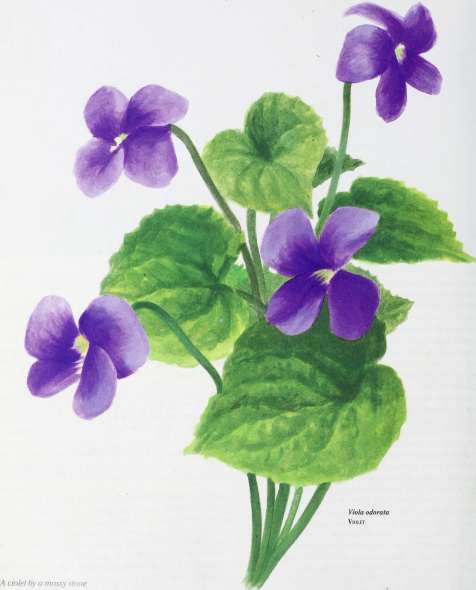
Half hidden from the eye! Fair as a star when only one
Is shining in the sky.
— “She Dwelt Among the Untrodden Ways,” William Wordsworth ( 1770 1850 ), English
V I T E X AGNUS-CASTUS
Vitex agnuS’Castus • Chaste Tree
FAMILY: Verbenaceae.
DESCRIPTION: Graceful aromatic shrub. Height: 10 to 20 feet (3 to 6.1 m). Flowers: Small, lavender to lilac, in dense clusters to 6 inches (15 cm). Leaves: Divided into 5 to 7 leaflets to 4 inches (10 cm), dark green with a gray underside. Blooms: July to August. HABITAT: Southern Europe, naturalized in warm areas, including the United States.
CULTIVATION: Perennial. Zone: 6 (needs mulch in zone 5). Germination: Stratify. Space: 3 feet (90 cm) or more. Soil Temperature: 60° to 70° F (15° to 21° C). Soil: Average, well drained, dry. Very drought tolerant. pH: 5.5 to 8.5. Sun: Full sun or partial shade. Propagation: In spring, by seed, cutting, or layering from young, woody cuttings. Prune back old growth in the late winter since leaves will sprout on new growth. A nice deer-proof shrub. GARDEN DESIGN: This small, graceful shrub is so attractive that a number of species are used as ornamentals in landscaping. It provides a lovely garden spot for shade-loving herbs or to shelter a seat for visitors.
CONSTITUENTS: Hormonal substances.
HISTORY: Both agnus and castus mean “’chaste”—a condition chaste berries were said to promote. The 1st century a.d. Roman Pliny wrote that the seeds reduced “sexual desire” and the 4th century B.c. Greek physician Hippocrates suggested eating them for spleen problems. Athenian women placed the leaves in the beds of virgins during the feast of the harvest goddess, Ceres, and are reported to have sometimes put them in their husband’s beds! The reputation for chastity continued into the Middle Ages when monks sprinkled the ground wild peppers, or piper agreste, liberally on their food to ensure continued chastity. It soon also became known as “monk’s pepper.” Italians still follow the old custom of strewing the flowers on the ground in front of novices as they enter the mionastery or convent. In the 13th century, two Arabic medical formularies, one by Al-Samarquandi and the other by Al-Kindi, mention chaste tree to treat epilepsy and even insanity. The fruits (seeds) are still sold today in Egyptian bazaars to calm hysteria. An herbal now called Agnus Castus was first translated from the original Latin around the 14th century. It received this name because these were the first 2 words of a text containing 248 plants. It suggests, among other things, combining chaste berries with fenkle (fennel) seed to treat dropsy and placing the berries on the head to eliminate headaches.
CULINARY: Only by monks! (See“History’.’)
MEDICINAL: Back in the 17th century, herbalist Gerard accurately wrote that the seeds and leaves helped with pain and inflammation of the uterus. (He also used them to treat the liver and spleen.) The hormonelike substances found in the seeds help to correct female hormonal imbalances—such as those that can occur during menopause, premenstrual syndrome, or menstruation— and also help dissolve fibroids and cysts.' German researchers suggest the berries increase production of luteinizing hormone and prolactin.^ Another study adds the increase of the hormone progesterone to the list.^ The seeds do stimulate mother’s milk flow, as shown in a clinical study when 100 nursing mothers taking chaste seeds were compared to those who were not. After reviewing German research, herbalist Christopher Hobbs suggests its use during the first 3 months only of pregnancy to help prevent miscarriage
and, with ginger, to allay morning sickness. Chaste berries can help regulate periods when there is excessive or too frequent bleeding.’' It also reestablishes normal ovulation after contraceptive pills have been used. Most of the research has been done on a chaste berry extract called Agnolyt. When 53 women with excessive bleeding and short menstrual cycles were given this product, 65% showed improvement and about 47% were entirely cured! Those over age twenty experienced the most improvement.^ Clinical studies with Agnolyt also found the chaste berry helps control acne in both young women and young men.® A booklet, Vitex! The Woman's Herb by Christopher Hobbs (Botanica Press, 1991), gives historic and medicinal information. An Asian and Australian native, \/ trifolia is used medicinally in India, Malaysia, and Indonesia. CONSIDERATIONS: According to information on Agnolyt, chaste berry may interfere with progesterone-containing medications. Also, it can delay the onset of menstruation a few days. OTHER: The stems are used in basketweaving.
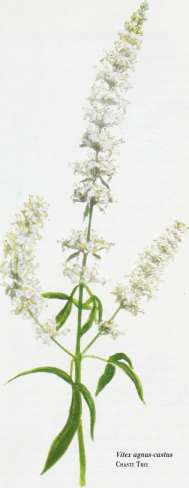
ZINGIBER OFFICINALE
%
Zingiber officinaie • Ginger
FAMILY: Zingiberaceae.
DESCRIPTION : Upright plant with stunning flowers. Height: 2 to 4 feet (.6 to 1.2 m). Width: IV 2 feet (45 cm). Flowers: Greenish flowers with cream blotches and purple edging, 3 inches (7.5 cm), growing on dense spikes. Leaves: Swordlike leaves that come to a sharp point, angling upwards, 1 foot (30 cm) by 1 inch (2.5 cm). Rhizome: Thick, tuberous, knotty, and sweetly fragrant. Blooms: Summer.
HABITAT: Originally from southeast Asia, ginger has been cultivated in many tropical countries for so long that it is no longer found wild.
CULTIVATION: Perennial. Zone: 10. Space: 1 foot (30cm). Soil: Rich, moist but well drained. pH: 4.5 to 7.5. Sun: Filtered sun or partial shade. Propagation: Cut the eyes from the rhizomes and plant. Not frost-hardy, but may be grown as an indoor plant if given special care and plenty of warmth and light. Prefers a greenhouse temperature around 75° F (24° C). It likes warm weather and humidity.
GARDEN DESIGN: Place the pots in the summer garden or grow in the garden year-round in warm climates. CONSTITUENTS: Essential oil (1% to 3%) includes zingi-berone, bisabolenel, oleoresins (shogaols are produced from gingerol as the root dries, making it twice as pungent); fats, vitamins A, B, minerals.
RELATED SPECIES: Not to be confused with wild ginger (Asarum canadense), a North American native with a similar smell, but much stronger chemistry, that is used as a ginger substitute only in very small amounts. There are several Australian native gingers {Alpinia species).
HISTORY: Ginger appears in the Analects of Chinese philosopher Confucius (551-479 B.C.). East Indian Susruta the Older’s Sanskrit text, Mushkakadigana (circa 4th century B.C.), called it sringavera, which described its shape as a “horn-root.” This became the Latin zingiber, the Greek zigiberis, the Spanish gengi-bre, the French ginjgimbre, and the English “ginger.” The Greeks were importing it from the East centuries before Dioscorides recorded its use in the 1st century a.d. In the early 16th century, the Spanish began cultivating and importing a superior-quality ginger from Jamaica. This is still preferred of the many grades, known as "races,” from the Spanish-Portuguese raices, or “root.” England’s Henry Vlll recommended ginger to fight the plague. Gingerbread was Queen Elizabeth I’s favorite sweet, a passion shared by Shakespeare’s Costard, who said “An 1 had but one penny in the world, thou shouldst have it to buy ginger-bread” (Love’s Labour’s Lost). CU LINAR Y: Ginger gives a “zing” to many Oriental main dishes and Indian chutneys (the Hindi word chatni means a “strong, spicy condiment”). Inspired by the Chinese, green ginger syrup became a delicacy in 15th-century Europe and is still produced in China today. Some New Englanders continue a custom borrowed centuries ago from England of passing around candied ginger after a meal. Eating gingerbread cookies at Christmas is another tradition borrowed from the English by Americans. The blue fruits of Australian native ginger were eaten by Aborigines.
MEDICINAL: The Chinese consider fresh gingerroot an important drug to treat colds and encourage sweating. They use dried ginger for respiratory and digestive disorders, such as gas and nausea. Its digestive enzyme, zingibain, is even more effective than papain from papaya.' Pregnant women also found that ginger relieved their morning sickness when they took 3 to 8 capsules first thing in the morning, before they got out of bed, and then 3 to 5 capsules at the first hint of nausea during the day. Ginger can prevent motion sickness better than even the popular drug, Dramamine® One study noted that 90% of those who took 2 to 4 capsules prior to traveling, with 2 more every hour if needed, experienced no nausea at all. It even helped people who usually got so sick, they rarely ventured from their houses. Dizziness and vertigo were reduced in 40% to 50% of the cases.^
Ginger stimalates circulation, warming cold hands and feet. A ginger tea encourages delayed menstruation, especially when the delay is due to cold or overexertion. East Africans use it to reduce headaches and kill parasites. As a vermifuge, scientists showed that all 42 components found in ginger oil effectively kill intestinal roundworms. Some of these worked better than the commonly prescribed piperazine citrate preparations.^ Ginger increases the availability of drugs and herbs by promoting absorption and protecting their destruction as they pass through the liver.'' AROMATHERAPY: Ginger liniments heat and relax sore muscles, ease menstrual cramps, and alleviate painful arthritic joints. It is a pick-me-up fragrance that combines especially well with citrus, as in lemon-ginger.
OTHER: A ginger suppository encourages showhorses to keep their tails up!
Crystallized Ginger
The best ginger for this recipe is the tender, juicy, young “stem ginger” found in Oriental markets in summer, but any fresh ginger will work.
1 pound (500 g) ginger Water to cover
3 cups (720 ml) sugar
2 tablespoons (30 ml) light corn syrup
3 cups (720 ml) water
Scrape off the thin skin of the ginger and trim off leaf bases. Slice into V-i-inch (6-mm) pieces. In a saucepan, place the ginger in enough water to cover by 2 inches (5 cm) and bring to a boil. Lower the heat, cover the pot, and simmer very low for about 3 hours, adding more water if needed. (A crock pot is ideal.)
Combine the sugar, syrup, and remaining water, and bring to a boil over medium heat for 2 minutes.
Add the ginger to the sugar mixture and heat to boiling again for 1 minute. Remove from heat and let stand until cool.
Return to heat and boil again, then turn down and simmer I to 3 hours, until the pieces are translucent and very tender. Add hot water if the syrup becomes too thick and starts to stick. Stir occasionally, cooking down to a spoonful of syrup. Fork the pieces onto a wire rack and let dry for a couple hours, then roll in granulated sugar. Store in a covered container.
ZINGIBER OFFICINALE
1
2
1
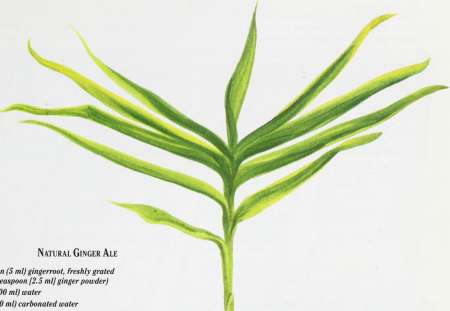
Natural Ginger Ale
teaspoon (5 ml) gingerroot, freshly grated
(or V 2 teaspoon (2.5 ml] ginger powder)
cups (500 ml) water
cup (240 ml) carbonated water
Juice of one lemon
Pinch of cayenne powder (optional)
Bring the ginger and plain water to a boil; then turn the heat to low and simmer 5 minutes. Remove from the heat, cover, and let steep an additional 10 minutes. Strain. Add carbonated water and lemon juice just before serving. Stirring in a pinch of cayenne powder brings out the "zing.”
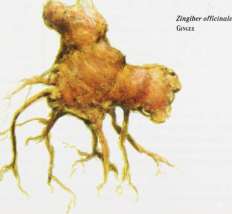
APPENDIX / :
Types of Herb Gardens

There are many kinds and styles of herb gardens to fit your design needs. Your herb garden can be as simple or as elaborate as you wish. Even the simplest herb garden will provide fragrance, colors, and textures, as well as tasty treats and natural medicines.
THE KITCHEN GARDEN The emphasis here is, of course, culinary herbs. Preferably, the garden should be located as near as possible to the kitchen door so fresh herbs are within reach. Paths in the garden are important for easy access, with the herbs most often used, such as parsley, planted along borders.
THE WILD GARDEN A wild garden allows the herbs to grow in natural patterns and to intermingle as they spread. Low-growing flowers can be set in informal patches. This doesn’t mean you can’t provide a few guidelines on where each one should grow. The wild garden isn’t a no-work garden, but it is certainly one of the easier ones to maintain.
THE TERRACED GARDEN Steep slopes may seem to be the last place you would want to plant an herb garden, but sucb a loca-
tion gives you an opportunity to create terraces that can be filled with trailing rosemary, fragrant geraniums, and colorful thymes hanging gracefully over the sides. The terraces can be tall to accommodate even large herbs or as shallow as a set of stairs. If you have the time or money, consider building stone walls.
THE GROUNDCOVER HERB GARDEN Groundcoversprovide an excellent way to fill in more space with herbs. Some herbs, like the low-growing Roman chamomile and pennyroyal, can actually be walked upon. Such herbs are perfect where lawn grass grows thin, such as under trees. They can also cover a sloped bank with color.
THE PATH GARDEN This is a strolling garden composed of the same low-growing herbs that are suitable for groundcovers. The plants themselves make wonderful, fragrant paths that fill the air
Your herb garden plan can be simple—or as elaborate as this extensive 17th century maze garden.
212
North Wind Picture Archives
APPENDIX I
with fragrance every time someone walks on them. Use herbs for the path itself, or create a path by scraping an area flat, then placing flagstones, bricks, wood rounds, or other suitable material in it, then filling in between the materials with some topsoil and herbs.
THE STRIP GARDEN If lack of yard space for your herb garden is a problem, plant a strip of herbs along a backfence or next to a walk. Although not the ideal placement for edible herbs, this garden looks attractive placed next to a driveway or along a road. It can either be a high hedge of trimmed herbs, like lavender and rosemary, or a more free-wheeling type such as tansy.
THE PLANTER BOX GARDEN An herb garden in planter boxes can solve many problems for gardeners who are restricted by lack of space or poor soil or for those who have a difficult time bending over. And, of course, the boxes are also portable, in case you are planning to move but can’t wait to begin your herb garden. Planter boxes can be made as tall as you need or desire. They have an advantage over pots in that the herbs don’t get rootbound or dry out so easily. Planter boxes are usually constructed out of wood, but more permanent ones can be constructed from cement. Small ones can be used as windowboxes. A small planter box of herbs makes a thoughtful gift.
THE POTTED HERB GARDEN If you live in an apartment,or just want to bring part of your herb garden closer to home, plant your herbs in pots. Many will grow nicely even on a windowsill or the railing of a porch. If they are inside, make sure they also get plenty of light, either through a window or under a grow light. Just be sure to choose a large enough pot so the herbs will have enough root space. Clay pots are attractive, but they need to be monitored closely since the soil can dry out quickly. If you don’t have time for constant watering or if you are going out of town, a saucer filled with water and placed under the pot allows water to “wick up” as needed. Still at a loss where to put your herb garden? You can always plant one in a large strawberry pot, with a different herb in each section. You’ll be restricted to the smaller varieties, but many herbs will adapt well.
THE FORMAL GARDEN A formal effect can be achieved by keeping herbs well trimmed and by leaving large spaces between them to make each one distinct. Separate them with grass, herbal groundcovers or crushed rock. Paths are often symmetrical, with low borders of well-trimmed herbs edging them. A bird bath, fountain, or sundial completes the effect.
A KNOT GARDEN The knot garden intertwines herbs like santolina, thyme, and germander into elaborate and symmetrical patterns. Gray santolina is a favorite because it can be trimmed, and also contrasts nicely with greener plants.
THE ROCK GARDEN These gardens are highlighted by rocks as well as by plants. They usually include many herbs, such as thyme and other plants that accent the shapes and textures of the stones.
THE HANGING GARDEN Hanging gardens aren’t a new idea, but they are rarely seen. The hanging garden is really a gar-
den in pots, except that the pots are suspended. It is not only a great space saver, but it is also an attractive way to show off cascading herbs. Hang them outside windows, along the edge of a porch or inside the house, especially above stairs or from a loft.
THE ARBOR GARDEN This is an overhead garden supported by an arbor, trellis, or gazebo. Quick-growing herbs such as hops, passionflower, and honeysuckle are excellent choices; or you may wish to grow climbing roses. The arbor garden can be accented with hanging pots or an herb-lined path.
THE POND GARDEN If you are lucky enough to have a pond —even a small one—try planting a garden around it. Mints will grow into the water and tall plants will tower above, lending their reflections to the water.
THE PERENNIAL FLOWER GARDEN Color is the main attraction of any flower garden. Here large, flowering herbs such as echinacea and butterfly weed provide stunning colors. This garden is not strictly an herb garden, and it can include perennial flowers whose only purpose is to provide colorful accents. If you already have a perennial flower garden, consider adding a few herbal flowers to it.
DRIED-FLOWER GARDEN If you are interested in making dried herbal wreaths and arrangements, a dried-flower garden will provide you with supplies for your craft. This is also by far the most colorful garden, even when fresh. Include easy access paths since most flowers must be picked continuously during the growing season, and so you’ll want room for you and your basket to move in between the plants.
THE EDIBLE GARDEN Granted, it is difficult to make an herb garden inedible, but if you want to emphasize the edible, stick to french sorrel, the bulbous fennel, and other herbs that can be eaten as vegetables; of course, add a few seasoning herbs too.
THE HERB AND VEGETABLE GARDEN Combining herbs with vegetables offers the benefits of natural insect repellents for your vegetables. Use annuals that can be turned under with the vegetables at the end of the season, or incorporate perennials and move them. Some gardeners choose to make islands within the vegetable garden where perennial herbs can live permanently.
THE “INSTANT” GARDEN If you have a greenhouse, you can keep your herbs in pots for an early spring start. When the weather warms, move the pots outside and sink them into the ground. Some herbs won’t reach full size, but you’ll have an orderly, quick-growing garden. In the fall, simply pop the pots out and turn under any weeds.
A THEME GARDEN If you want to be very creative with garden design, try different themes in sections of your garden, or make use of a single theme for the whole garden. A few ideas might include a fragrance garden, a garden of silver herbs of Artemisia, or a garden that attracts butterflies, including, of course, butterfly weed. Other possibilities are a medicinal garden or a natural dye garden. Herbs can also be divided by their uses or by the parts of the world from which they originate.
APPENDIX II
Hardiness Zone Map
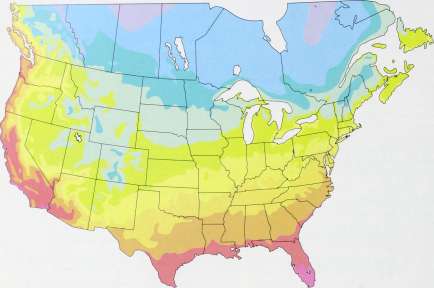
RANGE OF AVERAGE ANNUAL MINIMUM TEMPERATURES FOR EACH ZONE
ZONE 1 ZONE 2 ZONE 3 ZONE 4 ZONES ZONE 6 ZONE 7 ZONES ZONE 9

214
ZONE 10
APPENDIX III
History
Alpers, William C. The Em Formulary.
New York: DO Hayes & Co., 1914.
American Pharmaceutical Association.
The National Formulary of Unofficial Preparations. Third Ed. American Pharmaceutical Association, 1906.
Andrews, Jean. Peppers, The Domesticated Capsicums. Texas: University of Texas Press, 1985.
Bayard, Tania. Sweet Herbs and Sundry Flowers: Medieval Gardens and the Gardens of the Cloisters. New York: The Metropolitan Museum of Art, 1985.
Benedetti, Maria Dolores Hajosy. Earth and Spirit: Healing Lore and More from Puerto Rico. New Jersey: Waterfront Press, 1989.
Blunt, Wilfred, and Sandra Raphael. The Illustrated Herbal. New York: Thames and Hudson, Inc., 1979.
Boulos, Loutfy. Medicinal Plants of North America. 1983.
Burton, Jean. Lydia Pinkham is Her Name. New York: Farrar, Straus & Co., 1949.
Clarkson, Rosetta E. The Golden Age of Herbs and Herbalists. New York: Dover Publications, 1972.
Cooley, Arnold J. The Toilet and Cosmetic Arts in Ancient and Modern Times. New York: Burt Franklin, 1866. Reprinted 1970.
Cooke, Jean, et. al. History’s Timeline. New York: Crescent Books, 1981.
Culbreth, David. A Manual of Materia Medica and Pharmacology. New York: Lea & Febiger, 1917.
D’andrea, Jaenne. Ancient Herbs.
California: J. Paul Getty Museum, 1982.
Dana, Mrs. William Starr. How to Know the Wild Flowers. New York: Charles Scribner’s Sons, 1897.
deWaal, M. Medicinal Plants in the Bible. New York: Samuel Weiser, Inc., 1984. First Published in Dutch, Geneeskruiden in de Bijbel. W. N. Schors, 1909.
Duke, James A. Handbook of Northeastern Indian Medicinal Plants. Massachusetts: Quarterman Press, 1986.
Duke, James A. Medicinal Plants of the Bible. New York: Trado-Medic Books, 1983.
Duval, Marguerite. The King’s Garden. Virginia: The University Press of Virginia, 1982.
Further Reading
Erichsen-Brown, Charlotte. Medicinal and Other Uses of North American Plants. New York: Dover Publications, Inc. 1979.
Felter, Harvey Wickes, and John Uri Lloyd. King’s American Dispensatory. 18th ed.
2 vols. 1901. Reprint. Portland, Oregon: Eclectic Medicinal Publications, 1983.
Grieve, Maud. A Modern Herbal. New York: Dover Publications, 1971. Reprinted from 1931 edition.
Grimes, William, ed. Ethno-Botany of the Black Americans. Michigan: Reference Publications, 1979.
Harris, Lloyd J. The Book of Garlic: Lovers of the Stinking Rose. California:
Panjandrum Press, 1974.
Hechtlinger, Adelaide. The Great Patent Medicine Era. 1970. New York: Grosset and Dunlap, 1970.
Hedrick, UP, ed. Sturtevant’s Edible Plants of the World. New York: Dover Publications, 1979. Reprint of Sturtevant’s Notes of Edible Plants. Department of Agriculture, 1919.
Hutchens, Alma R. Indian Herbology of North America. Canada: Meerrco, 1969.
Kamm, Minnie Watson. Old-Time Herbs for Northern Gardens. Little, Brown and Co., 1938. Reprint. New York: Dover Publications, 1971.
Kerr, Ralph Whiteside. Herbalism Through the Ages. Tennessee: Kingsport Press, 1969.
MacNicol, \AdiXy. Flower Cookery. New York: Fleet Press Corp., 1967.
Majno, Guido. The Healing Hand: Man and Wound in the Ancient World. Massachusetts: Harvard University Press, 1975.
Martin, Laura C. Garden Flower Folklore. Connecticut: Globe Pequot Press, 1987.
Ibid. WildflowerFolklore. 1984.
McGrath, William, R. Amish Folk Remedies. Michigan: Whitmark Press, 1985.
McLean, Teresa. Medieval English Garden. New York: The Viking Press, 1980.
Miller, Amy Bess. Shaker Herbs, A History and a Compendium. New York: Clarkson N. Potter, Inc. 1976.
Moerman, Daniel E. Geraniums for the Iroquois: A Field Guide to American Indian Medicinal Plants. Michigan: Reference Publications, Inc., 1981.
Moldenke, Harold N. and Alma I. Plants of the Bible. New York: Dover Publications, 1952.
Morley, Brian D. Wild Flowers of the World. New York: Avenel Books, 1988. Reprinted from 1970 edition.
Morris, Dewin T. Fragrance. New York: Charles Scribner’s Sons, 1984.
Novotry, Ann & Carter Smith, ed. Images of Healing: A Portfolio of American Medical & Pharmaceutical Practice in the ISth, 19th S early 20th Centuries. New York: Macmillan Publishing Co., Inc., 1980.
Rohde, Eleanour Sinclair. A Garden of Herbs. New York: Dover Publications. (Originally Pub. 1936)
Root, Waverly. Food. New York: Simon and Schuster, 1980.
Remington, Joseph P. The Practice of Pharmacy: A Treatise. 3rd edition. L. B. Lippincott Co., 1889.
Roberts, Kate Louise. Hoyt’s New Cyclopedia of Practical Quotations. New York: Funk and Wagnalls Co., 1922.
Rosengarten, Frederick, Jr. The Book of Spices. New York: Pyramid Books, 1973.
Stack, Frederic William. Wild Flowers Every Child Should Know. New York: Grosset and Dunlap, 1909.
Stuart, Malcolm. The Encyclopedia of Herbs and Herbalism. New York: Crescent Books, 1979.
Svensson, Jon-Erik. Compendium of Early American Folk Remedies, Receipts S Advice. New York: Berkley Publishing Corp., 1977.
Swain, Tony. Plants in the Development of Modern Medicine. Massachusetts: Harvard University Press, 1972.
Vogel, Viril J. American Indian Medicine. Oklahoma: University of Oklahoma Press, 1970.
Wheelwright, Edith Grey. Medicinal Plants and Their History. New York: Dover Publications, 1974. Reprint of: The Physick Garden Medicinal Plants and their History. New York: Mifflin Co., 1934.
U. S. Pharmacopoeial Convention. The Pharmacopoeia of the United States of America. Ninth revision. J. B. Lippincott Co., 1916.
THE HISTORY OF HERBS
Wood, Horatio C., Jr. M.D. Pharmacology and Therapeutics for Students and Practitioners of Medicine. Philadelphia:
J. B. Lippincott Co., 1912.
Wood, Horatio C., Jr. M.D., and Arthur Osol, Ph.D. The Dispensatory of the United States of America. Twenty-third ed. Philadelphia:
J. B. Lippincott Co., 1943.
Young, James Harvey. The Medical Messiahs: Social History of Health Quackery in Twentieth-Century America. New Jersey: Princeton University Press, 1967.
Medicinal Herbs
Atal, C. K., and B. M. Kapur, ed. Cultivation and Utilization of Aromatic Plants. Jammu-Tawi, India: Regional Research Laboratory, 1982.
Bensky, D. and A. Camble. 1986. Chinese Herbal Medicine: Materia Medica. Washington: Eastland Press.
Blackwell, V7ill H. Poisonous and Medicinal Plants. New Jersey: Prentice Hall, 1990.
Bluementhal, Mark, ed. The Herbal Gram. Journal, vols. 1-24. 1983-1991. Texas: American Botanical Council.
Chan, H. and But, P. eds. 1986. Pharmacology and Applications of Chinese Materia Medica. vol. 1. Singapore: World Scientific.
Cracker, Lyle E., and James E. Simon, eds. Herbs, Spices and Medicinal Plants. volumes 1-4. Arizona: Oryx Press, 1986.
Culbreth, David. A Manual of Materia Medica and Pharmacology. New York: Lea & Febiger, 1917.
Dastur, J. F. Medicinal Plants of India and Pakistan. D. B. India: Taraporevalaa Sons and Co., 1962.
DerMarderosian, A., and Lawrence Liberti. Natural Products Medicine: A Scientific Guide to Foods, Drugs, Cosmetics. Philadelphia: George F. Stickly, 1988.
Duke, James A. Handbook of Medicinal Herbs. Florida: CRC Press, 1986.
Forrester, G. P. Pharmaceutical Formulas. Volumes 1-2.10th Edition. London: The Chemist and Druggist. 1934.
Foster, Steven and James Duke. Peterson Field Guide: Eastern/Central Medicinal Plants. Boston: Houghton Mifflin Co., 1990.
Foster, Steven.
Echinacea: The Purple Coneflowers. Botanical Series. Texas: American
Botanical Council. 1991.
Chamomiles, ibid. 1991.
Ginkgo, ibid. 1991.
Milk Thistle, ibid. 1991 Peppermint, ibid. 1991.
Green, James. Herbs & Health Care for the Male. California: Crossing Press, 1991.
Hardin, J. W, and J. M. Arena. Human Poisoning from Native and Cultivated Plants. Duke University Press, 1974.
Hobbs, Christopher.
The Echinacea Handbook. Oregon: Eclectic Medicinal Publications. 1983. Echinacea: The Immune Herb. Soquel:, Botanica Press. 1990.
Ginkgo: Elixir of Youth. Ibid. 1990.
Milk Thistle: The Liver Herb. Ibid. 1984. Comfrey. 1991.
Hoffmann, D. The Holistic Herbal. England: Findhorn Press, 1983.
Keville, Kathi, ed. American Herb Association Quarterly Newsletter, vols. 1-7. 1981-1991.
Krochmal, Arnold and Connie. A Guide to the Medicinal Plants of the United States. New York: Quadrangel, 1973.
Lad, Vasant, and David Frawley. The Yoga of Herbs: An Ayurvedic Guide to Herbal Medicine. New Mexico: Lotus Press, 1986.
Leung, Albert Y. Encyclopedia of Common Natural Ingredients Used in Food, Drugs and Cosmetics. New York: Wiley-Interscience, 1983.
Lewis, Walter H., and Memory P. F. Elvin-Lewis. Medical Botany: Plants Affecting Man’s Health. New York: John Wiley & Sons, 1977.
List, P. H., and Hormammer, L. Hager's Handbuch der Pharmazeutischen. vol. 2-6. Berlin: Springer-Verlag.
Lust, John. The Herb Book. New York: Bantam Books, 1974.
Maybe, Richard, ed. The New Age Herbalist. New York: Collier Books, 1988.
Mills, Simon Y, ed. The Dictionary of Modern Herbalism. New York: Thorsons Pub. Co., 1985.
Moore, Michael. Medicinal Plants of The Desert and Canyon West. New Mexico: Museum of New Mexico Press, 1989.
Ibid. Medicinal Plants of the Mountain West. New Mexico: Museum of New Mexico Press, 1979.
Mowrey, Daniel B. The Scientific Validation of Herbal Medicine. Cormorant Books,
1986.
Reid, Daniel P. Chinese Herbal Medicine. Shambala Press. Boston. 1987.
Satyavati, G. V., et. al. 1976. Medicinal Plants of India, vol. I. New Delhi, India: ICMR 217-19.
Stuart, Malcolm. The Encyclopedia of Herbs and Herbalism. New York: Crescent Books 1979.
Thomas, Clayton L., M.D. Taber’s Cyclopedia Medical Dictionary.
Philadelphia: F. A. Davis Co. 1981.
Tierra, Michael. Planetary Herbology. Santa Fe, NM: Lotus Press, 1988.
Tyler, Varro E., and Lynn R. Brady and James E. Robbers. Pharmacognosy. Ninth edition. Philadelphia: Lea & Febiger, 1988.
Wagner, H., and Hiroshi Hikino and Norman R. Farnsworth. Ed. Economic and Medicinal Plant Research. Vol. 1. New York: Academic Press, 1985.
Weiss, Rudolf Fritz. Herbal Medicine. Translated from 6th German ed. of Lehrbuch der Phytotherepie. A. R. Meuss. Beaconsfield, Eng.: Beaconsfield Pub. Ltd., 1988.
Wren, R. C. (revised by Williamson, Elizabeth M. and Fred J. Evans.) Potter’s New Cyclopedia of Botanical Drugs and Preparations. Essex, England: C. W. Daniel Co., Ltm., 1988.
Christopher, Dr. John R. School of Natural Healing. Springville, Utah: Christopher Publications, 1976.
Windholz, Martha, et. al., ed. The Merck Index: An Encyclopedia of Chemicals and Drugs. Ninth edition. Merck & Co. New Jersey, 1976.
Gardening Books
Atal, C. K., and B. M. Kapur, ed. Cultivation and Utilization of Aromatic Plants. Jammu-Tawi, India: Regional Research Laboratory, 1982.
Adams, James. Landscaping With Herbs. Oregon: Timber Press, 1987.
Art, Henry W. A Garden of Wild flowers. Vermont: Storey Communications, 1986.
Bailey, L. H. Cyclopedia of American Horticulture. Four volumes. New York:
The Macmillan Co., 1906.
Bailey, Liberty Hyde, and Ethel Zoe Bailey. Revision by L. H. Bailey Staff. Hortus Third. New York: Macmillan, 1976.
RESOURCES
Dobells, Inge N., ed. Magic and Medicine of Plants. New York: The Reader’s Digest Association, 1986.
Foster, Gertrude B., and Rosemary F. Louden. Park’s Success with Herbs. South Carolina: George W. Park Seed Co., 1980.
Foster, Steven. Herbal Bounty: The Gentle Art of Herb Culture. Utah: Gibbs M. Smith, Inc., 1984.
Garland, Sarah. The Herb Garden. New York: Penguin Books, 1984.
Genders, Roy. The Complete Book of Herbs and Herb Growing. New York: Sterling Publishing Co., 1980.
Periodicals
American Herb Association PO Box 1673 Nevada City, CA 95959 Membership in the AHA includes the newsletter, AHA Quarterly Newsletter, which is packed with current information, written and produced by herbalists. It includes scientific studies, book reviews, dialogs between herbalists, reports on controversies, environmental updates, legal issues, and more. Send SASE for brochure.
Foster’s Botanical & Herb Reviews PO Box 106
Eureka Springs, AR 72632
Quarterly review of books, periodicals, and
computer resources.
Herbal Gram PO Box 201660 Austin, TX 78720
Published by the American Botanical Council and written by researchers and scientists with information on herbs, news items, scientific conferences, herbal texts, and studies.
Medical Herbalism
PO Box 33080
Portland, OR 99723
Bi-monthly newsletter of clinical herb
studies for practitioners.
Ontario Herbalists Association Newsletter Box 253, Station J Toronto, ON M4T 4Y1
Mail Order Herbs, Plants, and Seeds
Abundant Life Seed Foundation PO Box 772
Port Townsend, WA 98368 Seeds.
Gilbertie, Sal, with Larry Sheehan. Herb Gardening at its Best. New York: Atheneum/SMI, 1984.
Kowalchik, Claire, and William H. Hylton, ed. Rodale’s Encyclopedia of Herbs. Emmaus, PA: Rodale Press, 1987.
Martin, Laura D. The Wildflower Meadow Book: A Gardener’s Guide. Connecticut:
The Globe Pequot Press, 1986.
Paterson, Allen. Herbs in the Garden. London: J. M. Denmt and Dons, Ltd., 1985.
Phillips, Harry R. Growing and Propagating Wild Flowers. North Carolina: University of North Carolina Press, 1985.
APPENDIX IV
Resources
Goodwin Creek Gardens Box 83
Williams, OR 97544 Plants and seeds.
Gardens of the Blue Ridge PO Box 10 Pineol, NC 28862 Plants.
The Herb Farm RR#4
Norton, NB EOG 2N0 Catalog $1.
Hilltop Herb Farm PO Box 1734 Cleveland, TX 77327 Plants.
Otto Richer & Sons, Ltd. Goodwood, ON LOC lAO Seeds.
Rpses of Yesterday and Today 802 Brown’s Valley Rd. Watsonville, CA 95076 Rose plants.
Tansy Farms RR#1 5888 Else Rd.
Aggasiz, BC VOM 1A4 Catalog $1.50.
Taylor’s Herb Garden 1535 Lone Oak Rd.
Vista, CA 92083 Plants.
Thompson & Morgan, Inc.
Box 1308
Jackson, NJ 08527 Seeds.
Well-Sweep Herb Farm 317 Mt. Bethel Rd.
Port Murray, NJ 07865 Plants.
Pizzetti, Ippolito, and Henry Cocker. Flowers: A Guide for Your Garden. 2 volumes. New York: Harry N. Abrams, Inc., 1968.
Reilly, Ann. Park’s Success with Seeds. South Carolina: George W. Park Seed Co., 1978.
Scheider, Alfred F. Park’s Success with Bulbs. South Carolina: George W. Park Seed Co., 1981.
Swanson, Faith H., and Virginia B. Rady. Herb Garden Design. Connecticut: University Press of New England, 1974.
Wright, John, I. Plant Propagation. London: Blandford Press, 1983.